Paul van Yperen's Blog, page 294
October 2, 2017
Helena Makowska
This week we follow the Le Giornate del Cinema Muto in Pordenone, Italy. One of the programmes is Cineteca Italiana 70, a celebration of the fact that Luigi Comencini and Alberto Lattuada founded the first Italian Cinematheque in 1947: Cineteca di Milano. The programme includes the drama Il Fiacre n. 13/Cab Number 13 (Alberto Capozzi, Gero Zambuto, 1917), one of the most popular films of Polish singer and actress Helena Makowska (1893-1964). She was a beautiful diva of the Italian silent cinema in the 1910s. During the 1920s, she moved to Berlin and became a star of the German cinema. Later, Luigi Comencini directed her in La valigia dei sogni/The Suitcase of Dreams (1953) as the aged actress of the silent era who is visibly moved by seeing herself in Fiacre 13.
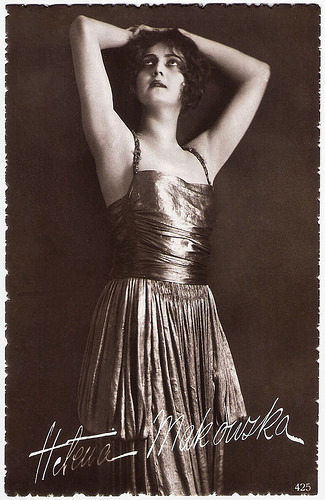
Italian postcard by Ed. A. Traldi, Milano, no. 425.
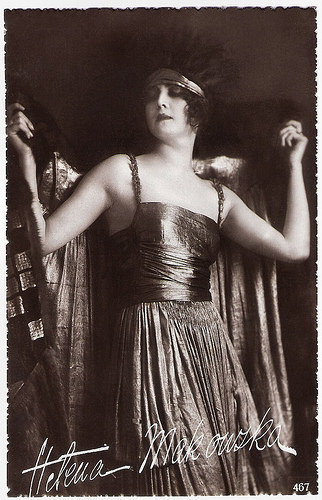
Italian postcard by Ed. A. Traldi, Milano, no. 467.
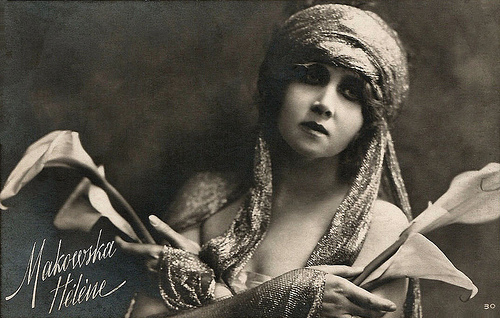
Italian postcard, no. 30. Collection: Didier Hanson.
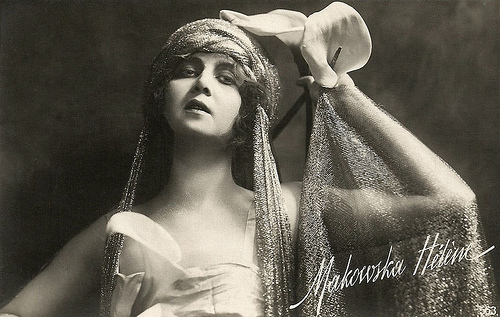
Italian postcard by Ed. A. Traldi, Milano, no. 563.
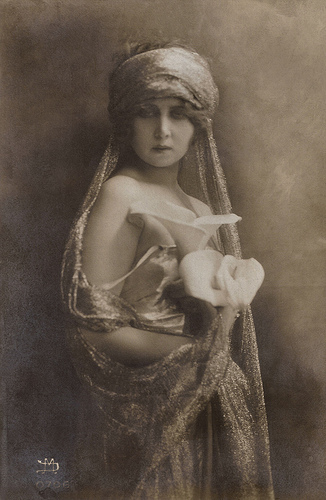
Italian postcard. Photo DM.
Beautiful and a bit Stiff
Helena (also Elena) Makowska was born Helena Woynowiczówna in Krivoy Rog, Russian Empire (now Kryvyi Rih, Ukraine), in 1893. She was the daughter of Ludwik Woyniewicz, a Polish engineer who worked for a Russian-Belgian company, and his wife Stanislawa née Sauret.
At the age of 16, she married lawyer Julian Makowski, but the marriage was a brief intermezzo. In 1912 Makowska went to Milan to take singing lessons. The following year she debuted at the Opera as Amelia in Il ballo in maschera and as Elena in Mefistofele.
Her film debut was in the film Romanticismo (Carlo Campogalliani, Arrigo Frusta, 1915). It was based on a famous play by Gerolamo Rovetta, which was already filmed in 1913, and refilmed in 1951.
Makowska is Anna Lamberti, whose husband count Vitaliano Lamberti ( Tullio Carminati ) would like to join the partizans, but is withheld by his pro-Austrian mother. His indecision has estranged him from his wife, who has an affair with a Polish profugee, Cezky, Vitaliano's secretary. When Vitaliano finally joins the freefighting patriots, he regains his wife's confidence, but her vengeful lover denounces Vitaliano to the police, then commits suicide. Even when warned, Vitaliano stays where he is, is caught and executed.
Romanticismo came out in Italy in September 1915, just a few months after the country had joined the Allied forces against Austria-Hungary and Germany in the First World War (April 1915). It was also Makowska's first film for the Torinese company Ambrosio.
From 1917 on, she switched to other film companies and played Ophelia in Ruggero Ruggeri's Amleto/Hamlet (1917), the seductress Elena in the comedy Addio giovinezza/Good-bye Youth (Augusto Genina, 1918) with Maria Jacobini , followed by La dame en gris/The Lady in Grey (Gian Paolo Rosmino, 1919).
Makowska would go on to perform in some 40 Italian films until her move to Germany in the early 1920s. The Italian press constantly praised her beauty but found her a bit stiff.
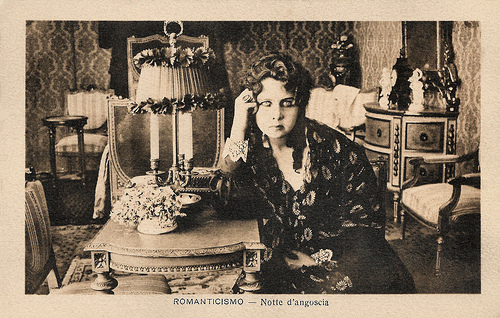
Italian postcard by IPA, no. CT. 750. Photo: Film della Società Anonima Ambrosio, Torino (Turin). Still from Romanticismo (1915). Caption: Notte d'angoscia (Night of anguish).
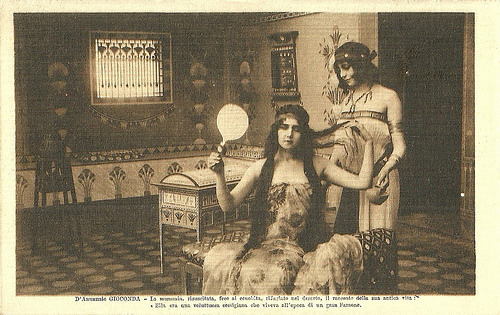
Italian postcard by IPA, no. CT. 3873. Photo: Film della Società Ambrosio, Torino. Publicity still of Helena Makowska as the Egyptian courtesan in La Gioconda (Eleuterio Rodolfi, 1916, released 1917), based on Gabriele D'Annunzio's play. Caption: The resurrected mummy told the monk, refugee in the desert, the story of her ancient life: She had been a voluptuous courtesan who lived in the times of the great Pharaon.'

Italian postcard by IPA CT, no. 3876. Photo: Film della Società Ambrosio, Torino. Publicity still of Helena Makowska in La Gioconda (Eleuterio Rodolfi, 1916, released 1917) with Umberto Mozzato as Lucio Settala and Helena Makowska as Gioconda Dianti. Caption: Lucio Settala is madly in love with his model Gioconda Dianti.
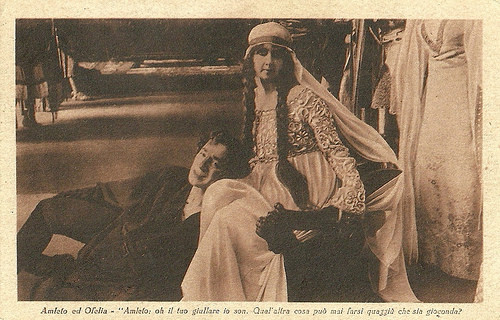
Italian postcard for the film Amleto (Eleuterio Rodolfi, 1917), adapted from William Shakespeare's play Hamlet, and starring Ruggero Ruggeri in the title role, and Helena Makowska as Ophelia. Caption: Hamlet: Oh, I am your jester. What else can one ever do down here that is joyous?
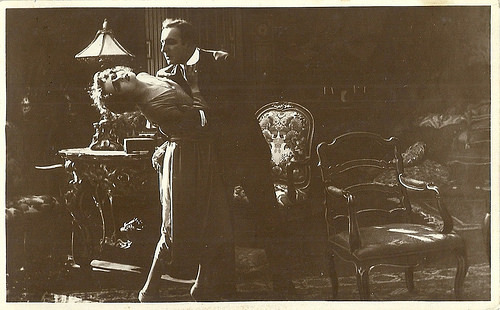
Italian postcard by Unione Cinematografica Italiana. Photo: Medusa Film. Publicity still for Idillio tragico (Gaston Ravel, 1922), based on a novel by Paul Bourget. Caption: Ely rejects Oliviero, as she has now fallen in love with Pietro di Hautefeuille.
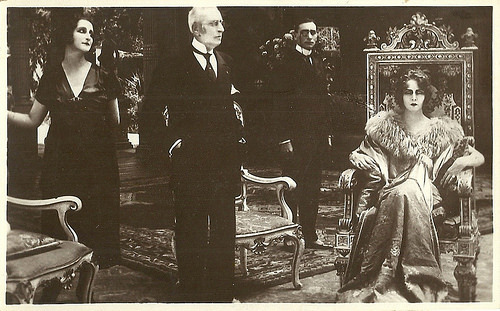
Italian postcard by Unione Cinematografica Italiana. Photo: Medusa Film. Publicity still for Idillio tragico (Gaston Ravel, 1922), based on a novel by Paul Bourget. Caption: Ely's sadness after Oliviero has abandoned her.
German Prison Camp
In the early 1920s, Helena Makowska moved to Berlin, where she remarried with actor Karl Falkenberg.
Between 1922 and 1927, Makowska played in some 15 films in Berlin and also in three in Warsaw, such as Judith/Frauen im Sumpf (1923) and Frauenmoral/Women's Morals (1923), both directed by Dutch director Theo Frenkel, Taras Bulba (Vladimir Strizevsky, Joseph N. Ermolieff, 1924) with Oscar Marion , the Stuart Webbs-detective Der Schuss im Pavillion/The Shot in the Pavillion (Max Obal, 1925), and Kochanka Szamoty/Szamota's Mistress (Leon Trystan, 1927), her last film in Poland.
After her return to Italy, rumors started to circulate that she had an affair with crown prince Umberto. In the early 1930s she married for the third time, now with an Englishman, Botteril, and returned to Poland, as an opera and operetta singer.
In 1939, immediately after the Germans occupied Poland, she was arrested as a British citizen and in 1940 she was deported to Berlin. After four years of prison camp, she was liberated in occasion of an exchange of prisoners.
In England she joined the theater ensemble of the Polish army, where she performed until the end of the war.
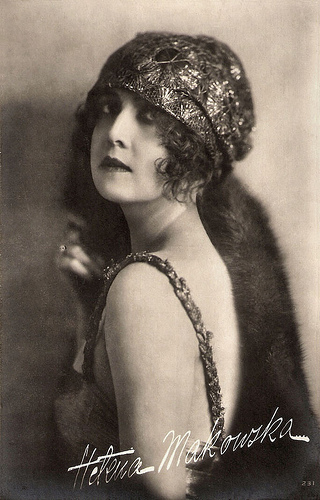
Italian postcard, no. 231.
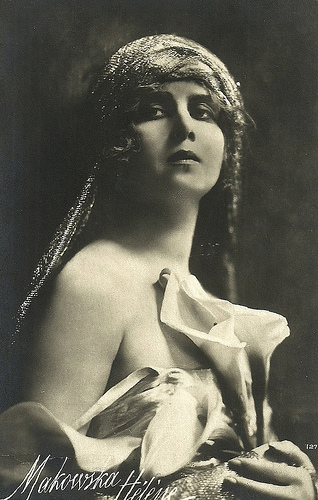
Italian postcard by Fotocelere, Torino, no. 127, with Romanian imprint by Editions SARPIC, Bucharest.
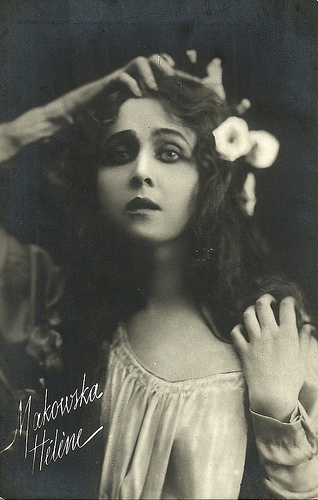
Italian postcard by Fotocelere, Torino, no. ?, with Romanian imprint by Editions SARPIC, Bucharest.
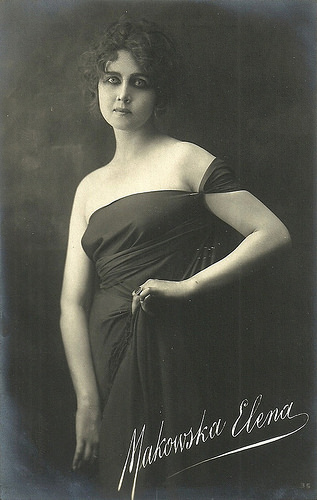
Italian postcard by Fotocelere, Torino, no. 35, with Romanian imprint by Editions SARPIC, Bucharest.
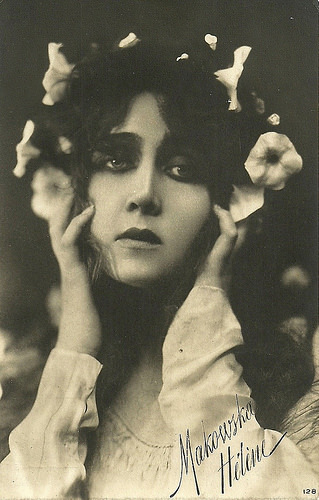
Italian postcard by Fotocelere, Torino, no. 128.
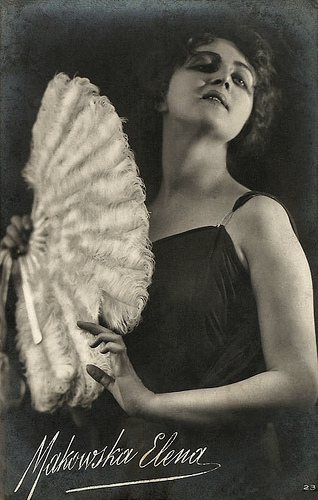
Italian postcard, no. 23. Collection: Didier Hanson.
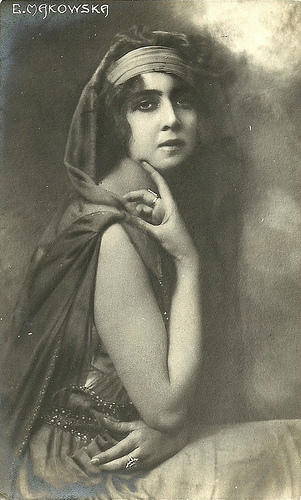
Italian postcard.
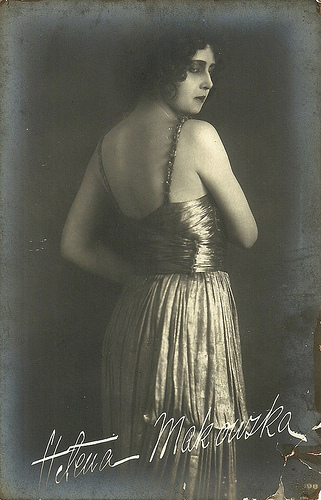
Italian postcard by Ed. Fotocelere, Torino.
Diva of Bygone Days
During her final years, Helena Makowska lived in Italy, where she did bit parts in Fabiola (Alessandro Blasetti, 1948) starring Michèle Morgan and Henri Vidal, and Quo vadis? (Mervyn LeRoy, 1951) with Robert Taylor and Deborah Kerr .
She appeared in Luigi Comencini's melancholic La valigia dei sogni/The Suitcase of Dreams (1953) as the aged actress of the silent era who is visibly moved by the performances of Lyda Borelli in La Donna Nuda/The Naked Truth (Carmine Gallone, 1914) and of herself in Fiacre 13/Cab Number 13 (Alberto Capozzi, Gero Zambuto, 1917), one of her most popular films.
In the film of Comencini, a modern audience of the 1950s cruelly laughs about the performances of the silent actresses, but the diva of bygone days sheds a tear over so much beauty and emotion.
Her final film appearance was in Arrivederci Firenze/Goodbye Firenze (Rate Furlan, 1958) with Maria-Pia Casilio .
Helena Makowska died in 1964 in Rome, Italy. She was 71. In 1999 director Peter Delpeut included footage of Makowska, Lyda Borelli , Pina Menichelli and other Italian silent film stars in his beautiful compilation film Diva Dolorosa (1999).
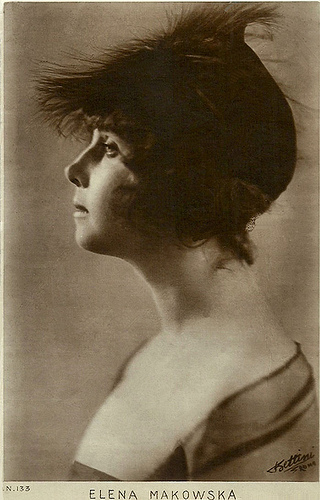
Italian postcard, no. 133. Photo: Bettini, Roma.
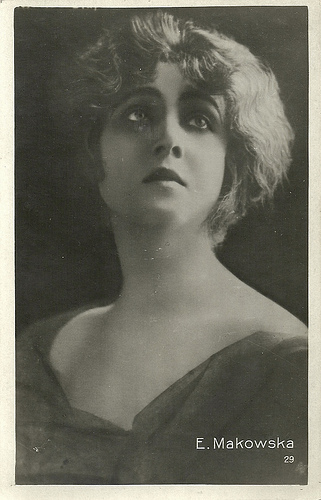
Italian postcard, no. 29.
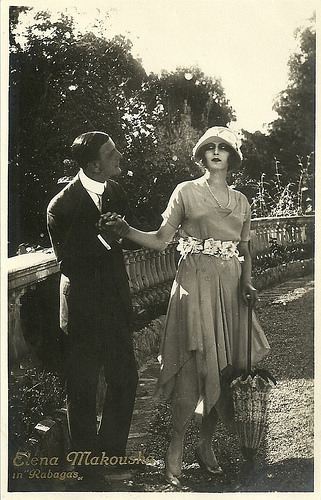
Italian postcard by G.B. Falci, Milano. Photo: Medusa Film / UCI. Publicity still for Rabagas (Gaston Ravel, 1922).
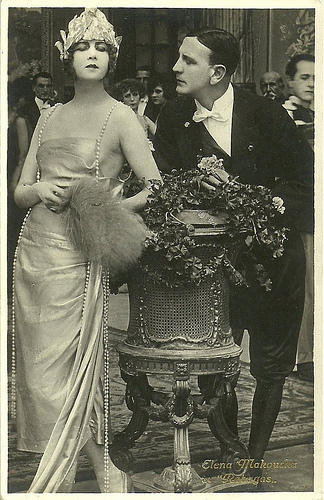
Italian postcard by G.B. Falci, Milano. Photo: Medusa Film / UCI. Publicity still for Rabagas (Gaston Ravel, 1922).
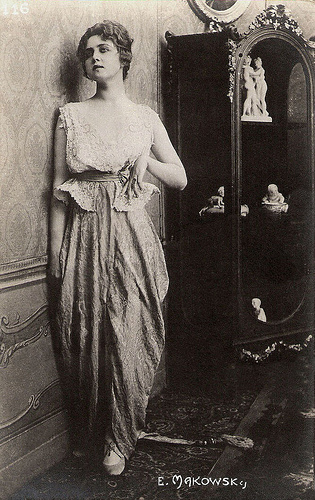
Italian postcard.
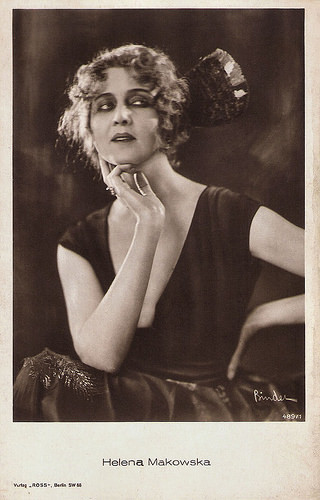
German postcard by Verlag Ross, Berlin, no. 489/1, 1919-1924. Photo: Alex Binder.

German postcard by Ross Verlag, no. 758/1, 1925-1926. Photo: Alex Binder. Collection: Didier Hanson.
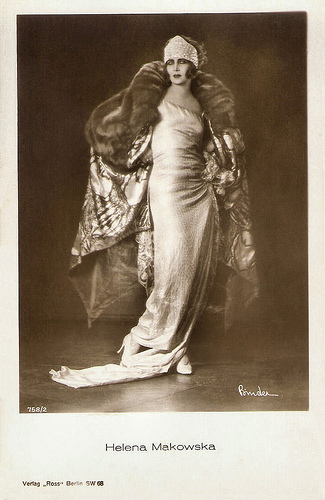
German postcard by Ross Verlag, no. 758/2, 1925-1926. Photo: Alex Binder.
Clip from Diva Dolorosa (1999). Source: The Stat (YouTube).
Source: Vittorio Martinelli (Le dive del silenzio), Wikipedia (German) and .

Italian postcard by Ed. A. Traldi, Milano, no. 425.

Italian postcard by Ed. A. Traldi, Milano, no. 467.

Italian postcard, no. 30. Collection: Didier Hanson.

Italian postcard by Ed. A. Traldi, Milano, no. 563.

Italian postcard. Photo DM.
Beautiful and a bit Stiff
Helena (also Elena) Makowska was born Helena Woynowiczówna in Krivoy Rog, Russian Empire (now Kryvyi Rih, Ukraine), in 1893. She was the daughter of Ludwik Woyniewicz, a Polish engineer who worked for a Russian-Belgian company, and his wife Stanislawa née Sauret.
At the age of 16, she married lawyer Julian Makowski, but the marriage was a brief intermezzo. In 1912 Makowska went to Milan to take singing lessons. The following year she debuted at the Opera as Amelia in Il ballo in maschera and as Elena in Mefistofele.
Her film debut was in the film Romanticismo (Carlo Campogalliani, Arrigo Frusta, 1915). It was based on a famous play by Gerolamo Rovetta, which was already filmed in 1913, and refilmed in 1951.
Makowska is Anna Lamberti, whose husband count Vitaliano Lamberti ( Tullio Carminati ) would like to join the partizans, but is withheld by his pro-Austrian mother. His indecision has estranged him from his wife, who has an affair with a Polish profugee, Cezky, Vitaliano's secretary. When Vitaliano finally joins the freefighting patriots, he regains his wife's confidence, but her vengeful lover denounces Vitaliano to the police, then commits suicide. Even when warned, Vitaliano stays where he is, is caught and executed.
Romanticismo came out in Italy in September 1915, just a few months after the country had joined the Allied forces against Austria-Hungary and Germany in the First World War (April 1915). It was also Makowska's first film for the Torinese company Ambrosio.
From 1917 on, she switched to other film companies and played Ophelia in Ruggero Ruggeri's Amleto/Hamlet (1917), the seductress Elena in the comedy Addio giovinezza/Good-bye Youth (Augusto Genina, 1918) with Maria Jacobini , followed by La dame en gris/The Lady in Grey (Gian Paolo Rosmino, 1919).
Makowska would go on to perform in some 40 Italian films until her move to Germany in the early 1920s. The Italian press constantly praised her beauty but found her a bit stiff.

Italian postcard by IPA, no. CT. 750. Photo: Film della Società Anonima Ambrosio, Torino (Turin). Still from Romanticismo (1915). Caption: Notte d'angoscia (Night of anguish).

Italian postcard by IPA, no. CT. 3873. Photo: Film della Società Ambrosio, Torino. Publicity still of Helena Makowska as the Egyptian courtesan in La Gioconda (Eleuterio Rodolfi, 1916, released 1917), based on Gabriele D'Annunzio's play. Caption: The resurrected mummy told the monk, refugee in the desert, the story of her ancient life: She had been a voluptuous courtesan who lived in the times of the great Pharaon.'

Italian postcard by IPA CT, no. 3876. Photo: Film della Società Ambrosio, Torino. Publicity still of Helena Makowska in La Gioconda (Eleuterio Rodolfi, 1916, released 1917) with Umberto Mozzato as Lucio Settala and Helena Makowska as Gioconda Dianti. Caption: Lucio Settala is madly in love with his model Gioconda Dianti.

Italian postcard for the film Amleto (Eleuterio Rodolfi, 1917), adapted from William Shakespeare's play Hamlet, and starring Ruggero Ruggeri in the title role, and Helena Makowska as Ophelia. Caption: Hamlet: Oh, I am your jester. What else can one ever do down here that is joyous?

Italian postcard by Unione Cinematografica Italiana. Photo: Medusa Film. Publicity still for Idillio tragico (Gaston Ravel, 1922), based on a novel by Paul Bourget. Caption: Ely rejects Oliviero, as she has now fallen in love with Pietro di Hautefeuille.

Italian postcard by Unione Cinematografica Italiana. Photo: Medusa Film. Publicity still for Idillio tragico (Gaston Ravel, 1922), based on a novel by Paul Bourget. Caption: Ely's sadness after Oliviero has abandoned her.
German Prison Camp
In the early 1920s, Helena Makowska moved to Berlin, where she remarried with actor Karl Falkenberg.
Between 1922 and 1927, Makowska played in some 15 films in Berlin and also in three in Warsaw, such as Judith/Frauen im Sumpf (1923) and Frauenmoral/Women's Morals (1923), both directed by Dutch director Theo Frenkel, Taras Bulba (Vladimir Strizevsky, Joseph N. Ermolieff, 1924) with Oscar Marion , the Stuart Webbs-detective Der Schuss im Pavillion/The Shot in the Pavillion (Max Obal, 1925), and Kochanka Szamoty/Szamota's Mistress (Leon Trystan, 1927), her last film in Poland.
After her return to Italy, rumors started to circulate that she had an affair with crown prince Umberto. In the early 1930s she married for the third time, now with an Englishman, Botteril, and returned to Poland, as an opera and operetta singer.
In 1939, immediately after the Germans occupied Poland, she was arrested as a British citizen and in 1940 she was deported to Berlin. After four years of prison camp, she was liberated in occasion of an exchange of prisoners.
In England she joined the theater ensemble of the Polish army, where she performed until the end of the war.

Italian postcard, no. 231.

Italian postcard by Fotocelere, Torino, no. 127, with Romanian imprint by Editions SARPIC, Bucharest.

Italian postcard by Fotocelere, Torino, no. ?, with Romanian imprint by Editions SARPIC, Bucharest.

Italian postcard by Fotocelere, Torino, no. 35, with Romanian imprint by Editions SARPIC, Bucharest.

Italian postcard by Fotocelere, Torino, no. 128.

Italian postcard, no. 23. Collection: Didier Hanson.

Italian postcard.

Italian postcard by Ed. Fotocelere, Torino.
Diva of Bygone Days
During her final years, Helena Makowska lived in Italy, where she did bit parts in Fabiola (Alessandro Blasetti, 1948) starring Michèle Morgan and Henri Vidal, and Quo vadis? (Mervyn LeRoy, 1951) with Robert Taylor and Deborah Kerr .
She appeared in Luigi Comencini's melancholic La valigia dei sogni/The Suitcase of Dreams (1953) as the aged actress of the silent era who is visibly moved by the performances of Lyda Borelli in La Donna Nuda/The Naked Truth (Carmine Gallone, 1914) and of herself in Fiacre 13/Cab Number 13 (Alberto Capozzi, Gero Zambuto, 1917), one of her most popular films.
In the film of Comencini, a modern audience of the 1950s cruelly laughs about the performances of the silent actresses, but the diva of bygone days sheds a tear over so much beauty and emotion.
Her final film appearance was in Arrivederci Firenze/Goodbye Firenze (Rate Furlan, 1958) with Maria-Pia Casilio .
Helena Makowska died in 1964 in Rome, Italy. She was 71. In 1999 director Peter Delpeut included footage of Makowska, Lyda Borelli , Pina Menichelli and other Italian silent film stars in his beautiful compilation film Diva Dolorosa (1999).

Italian postcard, no. 133. Photo: Bettini, Roma.

Italian postcard, no. 29.

Italian postcard by G.B. Falci, Milano. Photo: Medusa Film / UCI. Publicity still for Rabagas (Gaston Ravel, 1922).

Italian postcard by G.B. Falci, Milano. Photo: Medusa Film / UCI. Publicity still for Rabagas (Gaston Ravel, 1922).

Italian postcard.

German postcard by Verlag Ross, Berlin, no. 489/1, 1919-1924. Photo: Alex Binder.

German postcard by Ross Verlag, no. 758/1, 1925-1926. Photo: Alex Binder. Collection: Didier Hanson.

German postcard by Ross Verlag, no. 758/2, 1925-1926. Photo: Alex Binder.
Clip from Diva Dolorosa (1999). Source: The Stat (YouTube).
Source: Vittorio Martinelli (Le dive del silenzio), Wikipedia (German) and .
Published on October 02, 2017 23:00
October 1, 2017
Gösta Ekman
EFSP follows Le Gionate del Cinema Muto in Pordenone this week. One of the festival's programmes is Scandinavia, presenting two films starring Swedish actor Gösta Ekman: Thora van Deken/A Mother's Fight (John W. Brunius, 1920) and Vem dömer/Love's Crucible (Victor Sjöström, 1922). Ekman (1890-1938) was also the first real star of the Swedish theater. His boyish good looks attracted both sexes, helping to create a massive cult following, and elevating him to the status of a living legend. Combined with a beautiful voice, and a powerful stage and screen presence, Ekman was able to captivate his audiences.
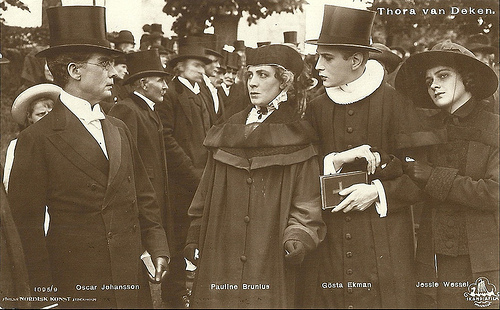
Swedish postcard by Verlag Nordisk Konst, Stockholm, no. 1095/9. Photo: Skandia Film. Publicity still for Thora van Deken/A Mother's Fight (John W. Brunius, 1920) with Oscar Johansson, Pauline Brunius, Gösta Ekman and Jessie Wessel.
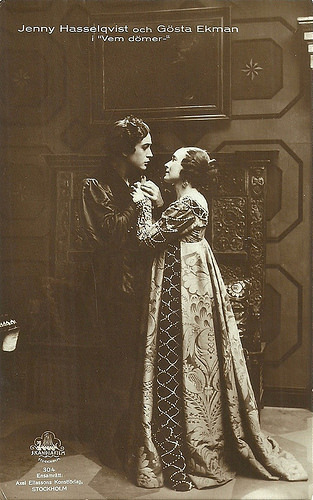
Swedish postcard by Axel Eliassons Konstförlag, Stockholm, no. 304. Photo: Skandia Film. Gösta Ekman and Jenny Hasselquist in the Swedish silent drama Vem döme/rLove's Crucible (Victor Sjöström, 1922).
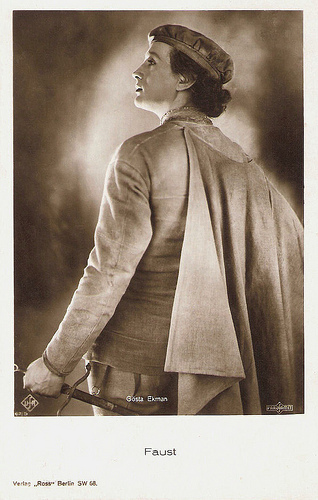
German postcard by Ross Verlag, no. 62/5. Photo: Ufa. Publicity still for Faust (Friedrich Wilhelm Murnau, 1926).
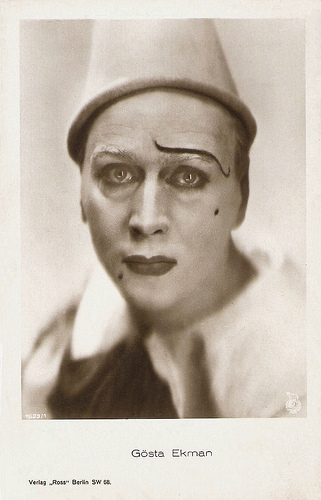
German postcard by Ross Verlag, no. 1623/1, 1927-1928. Photo: Nordisk. Publicity still for Klovnen/The Clown (A.W. Sandberg, 1926).
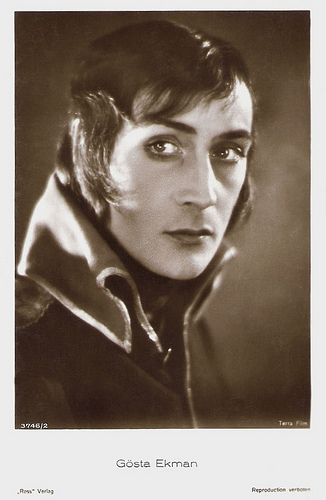
German postcard. Ross Verlag No. 3746/2. Terra Film. Gösta Ekman in the German silent film Revolutionshochzeit (A.W. Sandberg, 1928).
Master of Disguise
Gösta Ekman was born as Frans Gösta Viktor Ekman in Stockholm in 1890. He first entered the stage as an extra in 1906, but made his professional stage debut in the renowned Selander Company in 1911.
During his short life he enjoyed a prolific stage career, becoming a star of the Swedish theatre. He won acclaim for his classic portrayals, such as Lionel in Friedrich Schiller’s Maid of Orleans (1914), Claudio in Much Ado About Nothing (1916), and Romeo in Romeo and Juliet (1919).
Known as a self-taught master of disguise with theatre make-up and costumes, Gösta Ekman was equally convincing as a farmer's son, an 18th Century middle-aged aristocrat, or an 80-year old lunatic. Furthermore, he played in comedies, tragedies, dramas, and operettas. As a result, it was believed that he was capable of being convincing in all genres and as all types of characters.
At different times, he also ran and supervised several private theatres in Stockholm, including the Oscarsteatern, the Vasateatern, and the Konserthusteatern. He was also head of the Gothenburg City Theatre in the 1930s.
At the Vasateatern, which he ran from 1931 to 1935, he both directed and played the lead in several plays, while also producing a large number of productions. As a result, his time at the Vasateatern is considered to be the peak of his stage career.

Swedish postcard by Axel Eliassons Konstförlag, Stockholm, no. 413, mailed in 1916. Photo: Uno Falkengren, Göteborg.

Swedish postcard by Axel Eliassons Konstförlag, Stockholm, no. 21. Photo: Uno Falkengren, Nordiska Kompaniet, 1918.
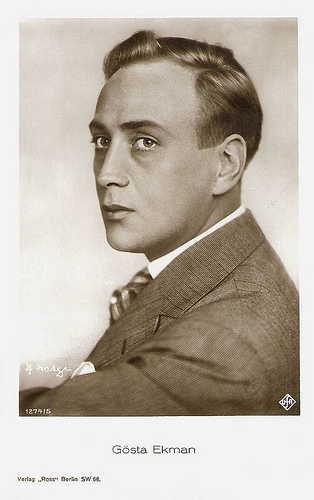
German postcard by Ross Verlag, no. 1274/5, 1927-1928. Photo: H. Natge / Ufa.
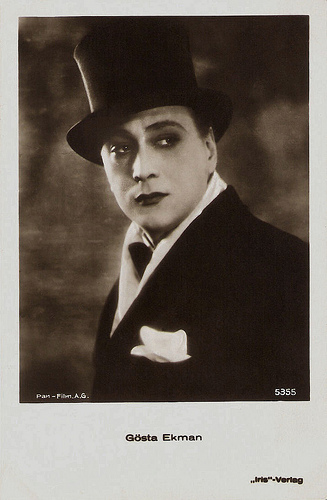
Austrian postcard by Iris-Verlag, no. 5355. Photo: Pan-Film A.G.
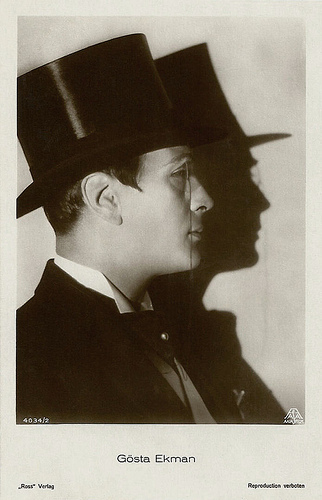
German postcard by Ross Verlag, no. 4034/2, 1929-1930. Photo: Aafa Film.
The Clown
Gösta Ekman started to appear in films at the dawn of the Swedish film industry, and played an important role in its development.
One of his first film roles was in Victor Sjöström 's experimental film Trädgårdsmästaren/The Broken Springrose (Victor Sjöström, 1912).
He also appeared in Den Okända/The Unknown Woman (Mauritz Stiller, 1913), Vem dömer/Love's Crucible (Victor Sjöström, 1922), and Karl XII/Charles XII (John W. Brunius, 1924-1925) made in two parts.
Ekman also starred in Nordisk Studio's most lucrative release of the 1920s, Klovnen/The Clown (1926), directed and co-written by A.W. Sandberg. This was a remake of a 1917 film with the same title, also written and directed by Sandberg.
Later, Gösta Ekman also played the lead in the first Swedish sound film, För hennes skull/For Her Sake (Paul Merzbach, 1930).
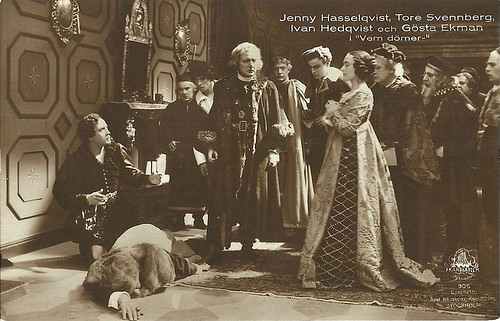
Swedish postcard by Axel Eliassons Konstforlag, no. 305. Photo: Skandia Film. Jenny Hasselquist , Ivan Hedqvist, Tore Svennberg and Gösta Ekman in Vem dömer/Love's Crucible (Victor Sjöström, 1922). The film is a Renaissance drama where a young woman named Ursula (Hasselquist), who is in love with Bertram, the son (Ekman) of the mayor (Svenberg), is accused of having poisoned her older husband, the sculptor Master Anton (Hedqvist). She has to prove her virginity through a fire test. The film's title reads: Who judges? NB. Nils Asther had a small part in this film. He is man just left of Hasselquist.
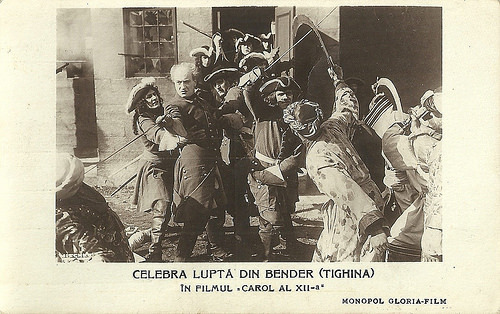
Romanian postcard. Photo: Monopol Gloria-Film. Gösta Ekman as the elder Swedish king Charles XII in the prestigious Swedish period piece Karl XII (John W. Brunius, 1925). Caption: The famous fight at Bender aka Tighina [a city in Moldova] in the film Karl XII.

Austrian postcard by Iris Verlag, no. 949. Photo: Nordisk Film / Lux Film Verleih. Publicity still for Klovnen/The Clown (A.W. Sandberg, 1926) with Karina Bell .
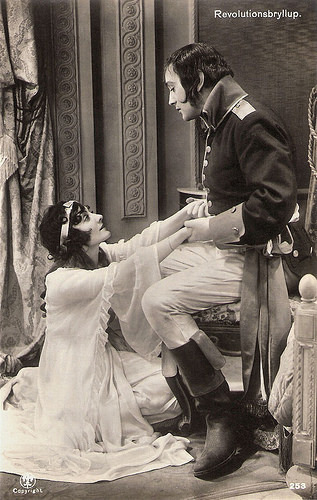
Danish postcard by Alex. Vincent's Kunstforlag, Eneret, no. 253. Photo: publicity still for Revolutionshochzeit/Revolutionsbryllup/The Last Night (A.W. Sandberg, 1928) with Diomira Jacobini .
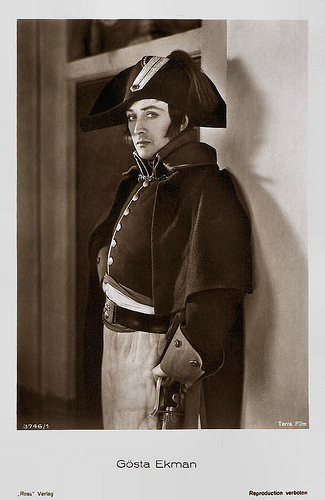
German postcard by Ross Verlag, no. 3746/1, 1928-1929. Photo: Terra Film. Publicity still for Revolutionshochzeit/Revolutionsbryllup/The Last Night (A.W. Sandberg, 1928).
The King
Gösta Ekman starred in two films that would gain international recognition.
In F.W. Murnau's silent film classic Faust (Friedrich Wilhelm Murnau, 1926), he played the title character opposite Emil Jannings as Mephisto.
And in the original version of Intermezzo (Gustaf Molander, 1936), where he played a world famous violinist opposite Ingrid Bergman in her breakout role.
Ekman and Bergman had already acted opposite each other in Swedenhielms/Swedenhielms Family (Gustaf Molander, 1935). They share a couple of wonderful scenes together as their characters have a heart-to-heart conversation on life and love, which are among the most memorable moments in the film.
His best on-screen credit is his double-role in the comedy Kungen kommer/The King Is Coming (Ragnar Hyltén-Cavallius, 1936), where Ekman masterfully plays first the king and then also the king's look-a-like; an actor who is hired by members of the Royal Court to impersonate His Majesty at a private party. Naturally the real king later arrives at the party causing a number of confusions and comic mix-ups.
Ekman co-directed himself in the film En Perfekt gentleman/A Perfect Gentleman (Vilhelm Bryde, 1927), in which he also starred opposite exotic star La Jana .

German postcard by Ross Verlag, no. 62/1. Photo: Parufamet. Publicity still for Faust (1926) with Hanna Ralph and Emil Jannings .
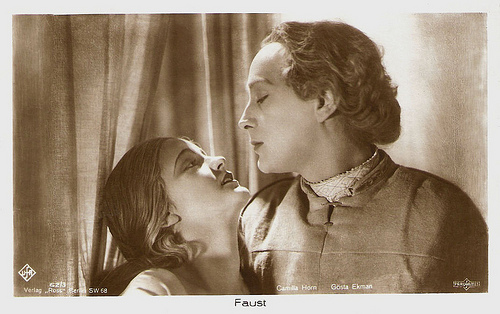
German postcard by Ross Verlag, no. 62/3. Photo: Parufamet. Publicity still for Faust (1926) with Camilla Horn .
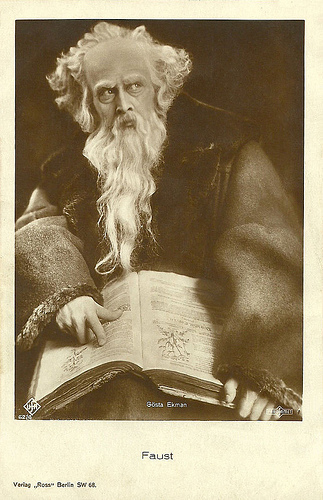
German postcard by Ross Verlag, no. 62/6. Photo: ParUfaMet / Ufa. Gösta Ekman in Faust (1926). Collection: Didier Hanson.
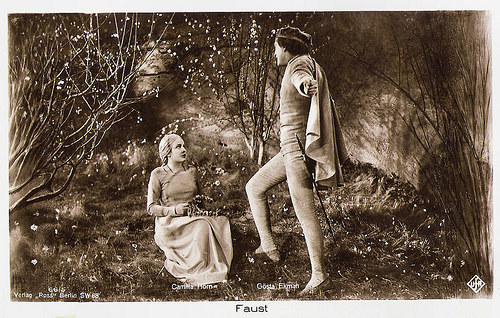
German postcard by Ross Verlag, no. 66/5. Photo: Ufa. Publicity still for Faust (1926) with Camilla Horn .
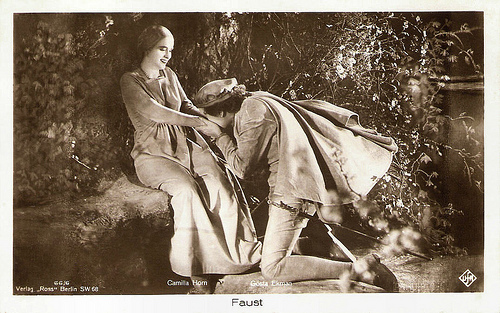
German postcard by Ross Verlag, no. 66/6. Photo: Ufa. Publicity still for Faust (1926) with Camilla Horn .
Cocaine
Early on, Gösta Ekman was labelled as a workaholic, sacrificing himself for his art and for his love of the theatre. Later, as his fame increased, his workload increased likewise.
During the day, he would rehearse and direct plays. In the evening, he played leading roles in stage plays. Later at night, he would film. This busy schedule left him with relatively little free time. Furthermore, the free time he did have was spent carrying out his duties as the administrative director of the theatres he ran.
In 1926, while filming Faust in Berlin, he was introduced to cocaine by two Scandinavians, who told him that the drug would help him to cope better with his work schedule. Sadly, this began a long-term drug addiction that slowly deteriorated his health and eventually caused his death 12 years later at the age of 47.
In 1914, Gösta Ekman had married Greta Sundström. Their son Hasse Ekman became one of Sweden's most successful film directors in the 1940s and early 1950s. Gösta Ekman's grandson, Gösta Ekman jr., was one of Sweden's finest actors. He passed away in April this year.
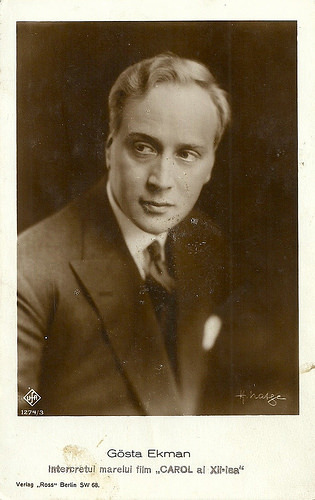
German postcard with Romanian imprint by Ross Verlag, no. 1274/3. Photo: H. Natger. Caption: Gösta Ekman in the great film Karl XII (John W. Brunius, 1925). Wikipedia mentions that the film 'because of its long running time of nearly six hours, it was released in two separate parts. The film depicts the life of Charles XII of Sweden (1682-1718) who oversaw the expansion of the Swedish Empire until its defeat at the Battle of Poltava. It was the most expensive production in Swedish history when it was made, and inspired a string of large budget Swedish historical films.'
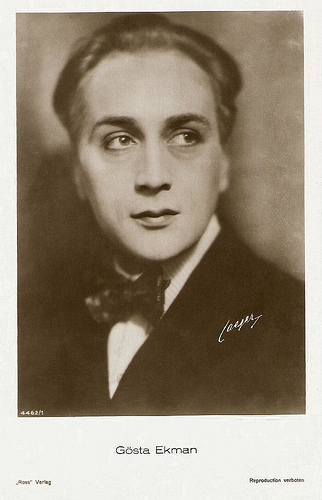
German postcard by Ross Verlag, no. 4462/1, 1929-1930. Photo: Jaeger (?).

Austrian postcard by Iris Verlag, no. 968. Photo: Nordisk Film / Lux Film Verleih.
DVD trailer for Faust (1926). Source: Kino International (YouTube).
Scene from Klovnen/The Clown (1926). Source: Vintagezelle (YouTube).
Sources: Wikipedia, Encyclopaedia Britannica, and .

Swedish postcard by Verlag Nordisk Konst, Stockholm, no. 1095/9. Photo: Skandia Film. Publicity still for Thora van Deken/A Mother's Fight (John W. Brunius, 1920) with Oscar Johansson, Pauline Brunius, Gösta Ekman and Jessie Wessel.

Swedish postcard by Axel Eliassons Konstförlag, Stockholm, no. 304. Photo: Skandia Film. Gösta Ekman and Jenny Hasselquist in the Swedish silent drama Vem döme/rLove's Crucible (Victor Sjöström, 1922).

German postcard by Ross Verlag, no. 62/5. Photo: Ufa. Publicity still for Faust (Friedrich Wilhelm Murnau, 1926).

German postcard by Ross Verlag, no. 1623/1, 1927-1928. Photo: Nordisk. Publicity still for Klovnen/The Clown (A.W. Sandberg, 1926).

German postcard. Ross Verlag No. 3746/2. Terra Film. Gösta Ekman in the German silent film Revolutionshochzeit (A.W. Sandberg, 1928).
Master of Disguise
Gösta Ekman was born as Frans Gösta Viktor Ekman in Stockholm in 1890. He first entered the stage as an extra in 1906, but made his professional stage debut in the renowned Selander Company in 1911.
During his short life he enjoyed a prolific stage career, becoming a star of the Swedish theatre. He won acclaim for his classic portrayals, such as Lionel in Friedrich Schiller’s Maid of Orleans (1914), Claudio in Much Ado About Nothing (1916), and Romeo in Romeo and Juliet (1919).
Known as a self-taught master of disguise with theatre make-up and costumes, Gösta Ekman was equally convincing as a farmer's son, an 18th Century middle-aged aristocrat, or an 80-year old lunatic. Furthermore, he played in comedies, tragedies, dramas, and operettas. As a result, it was believed that he was capable of being convincing in all genres and as all types of characters.
At different times, he also ran and supervised several private theatres in Stockholm, including the Oscarsteatern, the Vasateatern, and the Konserthusteatern. He was also head of the Gothenburg City Theatre in the 1930s.
At the Vasateatern, which he ran from 1931 to 1935, he both directed and played the lead in several plays, while also producing a large number of productions. As a result, his time at the Vasateatern is considered to be the peak of his stage career.

Swedish postcard by Axel Eliassons Konstförlag, Stockholm, no. 413, mailed in 1916. Photo: Uno Falkengren, Göteborg.

Swedish postcard by Axel Eliassons Konstförlag, Stockholm, no. 21. Photo: Uno Falkengren, Nordiska Kompaniet, 1918.

German postcard by Ross Verlag, no. 1274/5, 1927-1928. Photo: H. Natge / Ufa.

Austrian postcard by Iris-Verlag, no. 5355. Photo: Pan-Film A.G.

German postcard by Ross Verlag, no. 4034/2, 1929-1930. Photo: Aafa Film.
The Clown
Gösta Ekman started to appear in films at the dawn of the Swedish film industry, and played an important role in its development.
One of his first film roles was in Victor Sjöström 's experimental film Trädgårdsmästaren/The Broken Springrose (Victor Sjöström, 1912).
He also appeared in Den Okända/The Unknown Woman (Mauritz Stiller, 1913), Vem dömer/Love's Crucible (Victor Sjöström, 1922), and Karl XII/Charles XII (John W. Brunius, 1924-1925) made in two parts.
Ekman also starred in Nordisk Studio's most lucrative release of the 1920s, Klovnen/The Clown (1926), directed and co-written by A.W. Sandberg. This was a remake of a 1917 film with the same title, also written and directed by Sandberg.
Later, Gösta Ekman also played the lead in the first Swedish sound film, För hennes skull/For Her Sake (Paul Merzbach, 1930).

Swedish postcard by Axel Eliassons Konstforlag, no. 305. Photo: Skandia Film. Jenny Hasselquist , Ivan Hedqvist, Tore Svennberg and Gösta Ekman in Vem dömer/Love's Crucible (Victor Sjöström, 1922). The film is a Renaissance drama where a young woman named Ursula (Hasselquist), who is in love with Bertram, the son (Ekman) of the mayor (Svenberg), is accused of having poisoned her older husband, the sculptor Master Anton (Hedqvist). She has to prove her virginity through a fire test. The film's title reads: Who judges? NB. Nils Asther had a small part in this film. He is man just left of Hasselquist.

Romanian postcard. Photo: Monopol Gloria-Film. Gösta Ekman as the elder Swedish king Charles XII in the prestigious Swedish period piece Karl XII (John W. Brunius, 1925). Caption: The famous fight at Bender aka Tighina [a city in Moldova] in the film Karl XII.

Austrian postcard by Iris Verlag, no. 949. Photo: Nordisk Film / Lux Film Verleih. Publicity still for Klovnen/The Clown (A.W. Sandberg, 1926) with Karina Bell .

Danish postcard by Alex. Vincent's Kunstforlag, Eneret, no. 253. Photo: publicity still for Revolutionshochzeit/Revolutionsbryllup/The Last Night (A.W. Sandberg, 1928) with Diomira Jacobini .

German postcard by Ross Verlag, no. 3746/1, 1928-1929. Photo: Terra Film. Publicity still for Revolutionshochzeit/Revolutionsbryllup/The Last Night (A.W. Sandberg, 1928).
The King
Gösta Ekman starred in two films that would gain international recognition.
In F.W. Murnau's silent film classic Faust (Friedrich Wilhelm Murnau, 1926), he played the title character opposite Emil Jannings as Mephisto.
And in the original version of Intermezzo (Gustaf Molander, 1936), where he played a world famous violinist opposite Ingrid Bergman in her breakout role.
Ekman and Bergman had already acted opposite each other in Swedenhielms/Swedenhielms Family (Gustaf Molander, 1935). They share a couple of wonderful scenes together as their characters have a heart-to-heart conversation on life and love, which are among the most memorable moments in the film.
His best on-screen credit is his double-role in the comedy Kungen kommer/The King Is Coming (Ragnar Hyltén-Cavallius, 1936), where Ekman masterfully plays first the king and then also the king's look-a-like; an actor who is hired by members of the Royal Court to impersonate His Majesty at a private party. Naturally the real king later arrives at the party causing a number of confusions and comic mix-ups.
Ekman co-directed himself in the film En Perfekt gentleman/A Perfect Gentleman (Vilhelm Bryde, 1927), in which he also starred opposite exotic star La Jana .

German postcard by Ross Verlag, no. 62/1. Photo: Parufamet. Publicity still for Faust (1926) with Hanna Ralph and Emil Jannings .

German postcard by Ross Verlag, no. 62/3. Photo: Parufamet. Publicity still for Faust (1926) with Camilla Horn .

German postcard by Ross Verlag, no. 62/6. Photo: ParUfaMet / Ufa. Gösta Ekman in Faust (1926). Collection: Didier Hanson.

German postcard by Ross Verlag, no. 66/5. Photo: Ufa. Publicity still for Faust (1926) with Camilla Horn .

German postcard by Ross Verlag, no. 66/6. Photo: Ufa. Publicity still for Faust (1926) with Camilla Horn .
Cocaine
Early on, Gösta Ekman was labelled as a workaholic, sacrificing himself for his art and for his love of the theatre. Later, as his fame increased, his workload increased likewise.
During the day, he would rehearse and direct plays. In the evening, he played leading roles in stage plays. Later at night, he would film. This busy schedule left him with relatively little free time. Furthermore, the free time he did have was spent carrying out his duties as the administrative director of the theatres he ran.
In 1926, while filming Faust in Berlin, he was introduced to cocaine by two Scandinavians, who told him that the drug would help him to cope better with his work schedule. Sadly, this began a long-term drug addiction that slowly deteriorated his health and eventually caused his death 12 years later at the age of 47.
In 1914, Gösta Ekman had married Greta Sundström. Their son Hasse Ekman became one of Sweden's most successful film directors in the 1940s and early 1950s. Gösta Ekman's grandson, Gösta Ekman jr., was one of Sweden's finest actors. He passed away in April this year.

German postcard with Romanian imprint by Ross Verlag, no. 1274/3. Photo: H. Natger. Caption: Gösta Ekman in the great film Karl XII (John W. Brunius, 1925). Wikipedia mentions that the film 'because of its long running time of nearly six hours, it was released in two separate parts. The film depicts the life of Charles XII of Sweden (1682-1718) who oversaw the expansion of the Swedish Empire until its defeat at the Battle of Poltava. It was the most expensive production in Swedish history when it was made, and inspired a string of large budget Swedish historical films.'

German postcard by Ross Verlag, no. 4462/1, 1929-1930. Photo: Jaeger (?).

Austrian postcard by Iris Verlag, no. 968. Photo: Nordisk Film / Lux Film Verleih.
DVD trailer for Faust (1926). Source: Kino International (YouTube).
Scene from Klovnen/The Clown (1926). Source: Vintagezelle (YouTube).
Sources: Wikipedia, Encyclopaedia Britannica, and .
Published on October 01, 2017 22:00
September 30, 2017
Roscoe 'Fatty' Arbuckle
EFSP follows Le Gionate del Cinema Muto in Pordenone this week. One of the films shown is The Butcher Boy (1917) in which Buster Keaton made his film debut - 100 years ago. Director was American silent film actor and comedian Roscoe ‘Fatty’ Arbuckle (1887-1933), who was himself also one of the most popular silent stars of the 1910s. Arbuckle started at the Selig Polyscope and moved to Keystone Studios, where he worked with Mabel Normand and Harold Lloyd. Arbuckle mentored Charlie Chaplin and discovered Keaton and Bob Hope. In 1920, he signed a contract with Paramount Pictures for US$1 million. Between November 1921 and April 1922, Arbuckle was the defendant in three widely publicised trials for the rape and manslaughter of starlet Virginia Rappe. Following the trials, his films were banned and he was publicly ostracised. Arbuckle only later worked as a film director under the alias William Goodrich. He was finally able to return to acting, making short two-reel comedies in 1932 for Warner Bros. He died in his sleep of a heart attack in 1933 at age 46, on the same day he signed a contract with Warner Brothers to make a feature film.
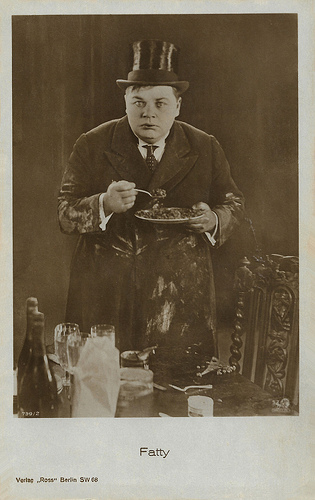
German postcard by Ross Verlag, no. 799/2, 1925-1926. Photo: Phoebus Film.
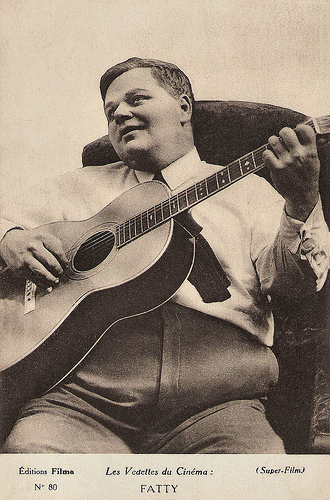
French postcard by Éditions Filma in the Les Vedettes du Cinéma series, no. 80. Photo: Super-Film.
Bowler-hat and pants whose legs were too short
Roscoe Conkling Arbuckle was born in 1887 in Smith Center, Kansas, one of nine children of Mary E. 'Mollie' Gordon and William Goodrich Arbuckle. His family moved to California when he was a year old.
Arbuckle had a wonderful singing voice and was extremely agile. At the age of eight, with his mother's encouragement, he first performed on stage with Frank Bacon's company. Arbuckle enjoyed performing and continued on until his mother's death in 1899 when he was 12.
His father, who had always treated him harshly, now refused to support him and Arbuckle got work doing odd jobs in a hotel. Arbuckle was in the habit of singing while he worked and was overheard by a customer who was a professional singer. The customer invited him to perform in an amateur talent show. He not only won the competition but began a career in vaudeville.
In 1904, Sid Grauman invited Arbuckle to sing illustrated songs in his new Unique Theater in San Francisco. He then joined the Pantages Theatre Group touring the West Coast of the United States and in 1906 played the Orpheum Theater in Portland, Oregon in a vaudeville troupe organised by Leon Errol. Arbuckle became the main act and the group took their show on tour.
In 1908, Arbuckle married Minta Durfee, who later starred in many early comedy films, often with Arbuckle. Arbuckle then joined the Morosco Burbank Stock vaudeville company and went on a tour of China and Japan returning in early 1909.
That year, Arbuckle began his film career with the Selig Polyscope Company when he appeared in Ben's Kid (Francis Boggs, 1909). He appeared sporadically in Selig one-reelers until 1913, moved briefly to Universal Pictures.
Then, Arbuckle went to work in producer-director Mack Sennett's Keystone Cops comedies. His character Fatty – he weighed 135 kilogrammes at the height of his career - usually wore bowler-hat and pants whose legs were too short. For the next 3-1/2 years he appeared in hundreds of one-reel comedies, mostly as policemen, but he also played different parts.
He would work with Mabel Normand, Ford Sterling, among others, and would learn about the process of making films from Henry Lehrman, who directed many of his pictures. Despite his massive physical size, Arbuckle was remarkably agile and acrobatic. His comedies are noted as rollicking and fast-paced, have many chase scenes, and feature sight gags.
Arbuckle was fond of the ‘pie in the face’, a comedy cliche that has come to symbolise silent-film-era comedy itself. The earliest known custard pie thrown in film was in the Keystone one-reeler A Noise from the Deep (Mack Sennett, 1913). The pie was thrown by Mabel Normand and Arbuckle was the recipient.
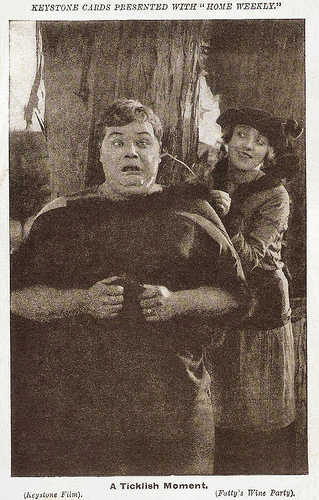
American postcard by Keystone cards, presented with Home Weekly. Photo: Keystone Film. Publicity still for Fatty's Wine Party (Roscoe 'Fatty' Arbuckle, 1914) with Fatty Arbuckle and Mabel Normand. Caption: A Ticklish Moment.

American postcard by Keystone cards, presented with Home Weekly. Photo: Keystone Film. Publicity still for Fatty's Chance Acquaintance ( Roscoe 'Fatty' Arbuckle, 1915) with Billie Bennett.
A then-unheard-of offer
By 1914 Roscoe Arbuckle had begun directing some of his one-reels. Paramount Pictures made the then-unheard-of offer of US$1,000-a-day plus 25% of all profits and complete artistic control to make films with Arbuckle and Normand.
The next year he had moved up to two-reels, which meant that he would need to sustain the comedy to be successful - as it turned out, he was. Among his films were Fatty Again (Roscoe 'Fatty' Arbuckle, 1914), Mabel, Fatty and the Law (Roscoe 'Fatty' Arbuckle,1915), Mabel and Fatty's Wash Day (Roscoe 'Fatty' Arbuckle, 1915), Mabel and Fatty Viewing the World's Fair at San Francisco (Roscoe 'Fatty' Arbuckle, 1915), Fatty's Reckless Fling (Roscoe 'Fatty' Arbuckle, 1915) with Edgar Kennedy, and many more.
Charles Chaplin assisted Arbuckle in The Knockout (Mack Sennett, 1914); and Harold Lloyd was his co-star in Miss Fatty's Seaside Lovers (Roscoe 'Fatty' Arbuckle, 1915). He also hired a young performer he met in New York by the name of Buster Keaton .
Keaton's film career would start with Roscoe in The Butcher Boy (Roscoe 'Fatty' Arbuckle, 1917). Keaton supported him in at least 14 shorts. The films were so lucrative and popular that in 1918 Paramount offered Arbuckle a three-year, $3 million contract ($48,000,000 in 2016 dollars).
In 1916, Arbuckle had started his own film company, Comique, in partnership with Joseph Schenck. Although Comique produced some of the best short pictures of the silent era, in 1918 Arbuckle transferred his controlling interest in the company to Buster Keaton and accepted Paramount's $3 million offer to make up to 18 feature films over three years.
Roscoe's first feature was the Western comedy The Round-Up (George Melford, 1920) and it was successful. It was soon followed by other features, including Brewster's Millions (Joseph Henabery, 1921) and Gasoline Gus (James Cruze, 1921) with Lila Lee.
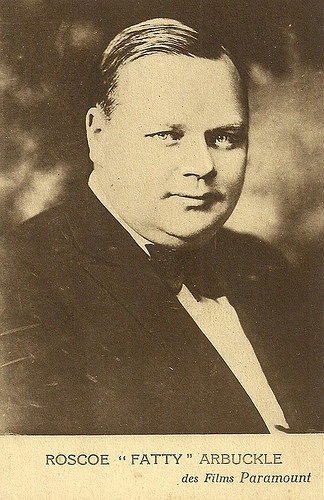
French postcard by Edition Paramount, Paris.
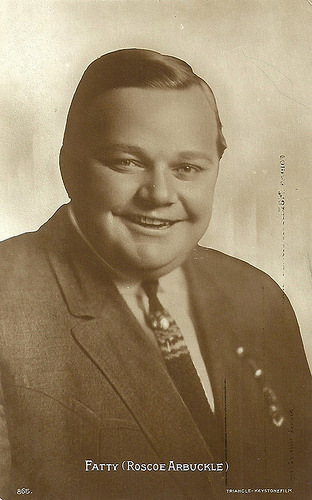
Swedish postcard by Forlag Nordisk Konst, Stockholm, no. 865. Photo: Triangle-Keystonefilm.
The Death of Virginia Rappe
On 5 September 1921, Roscoe Arbuckle took a break from his hectic film schedule and, drove to San Francisco with two friends, Lowell Sherman and Fred Fishback. The three checked into three rooms at the St. Francis Hotel. They invited several women to their suite.
During the carousing, a 26-year-old starlet named Virginia Rappe was found seriously ill and was examined by the hotel doctor, who concluded her symptoms were mostly caused by intoxication, and gave her morphine to calm her. Rappe was not hospitalised until two days after the incident.
Virginia Rappe suffered from chronic cystitis, a condition that liquor irritated dramatically. Her heavy drinking habits and the poor quality of the era's bootleg alcohol could leave her in severe physical distress. She had undergone several abortions in the space of a few years, and she was preparing to undergo another.
At the hospital, Rappe's companion at the party, Bambina Maude Delmont, told Rappe's doctor that Arbuckle had raped her friend. The doctor examined Rappe but found no evidence of rape. Rappe died one day after her hospitalization of peritonitis, caused by a ruptured bladder. Delmont then told police that Arbuckle raped Rappe, and the police concluded that the impact Arbuckle's overweight body had on Rappe eventually caused her bladder to rupture. Delmont later made a statement incriminating Arbuckle to the police in an attempt to extort money from Arbuckle's attorneys.
Arbuckle's trial was a major media event; exaggerated and sensationalized stories ran in William Randolph Hearst's nationwide newspaper chain. The resulting scandal destroyed Arbuckle's career and his personal life. In his testimony, Arbuckle denied he had any knowledge of Rappe's illness.
The first trial (14 November-4 December 1921) ended with the jury deadlocked 10 to 2 in favor of acquittal. The second trial (11 January -3 February 1922) also ended in a hung jury; this time the majority had ruled against Roscoe - 10 to 2 for conviction. The third trial (13 March – 12 April 1922) finally ended with an acquittal and a formal statement of apology to Arbuckle for putting him through the ordeal; a dramatic move in American justice.
At the time of his acquittal, Arbuckle owed over $700,000 in legal fees to his attorneys for the three criminal trials, and he was forced to sell his house and all of his cars to pay some of the debt. Although he had been cleared of all criminal charges, the scandal had greatly damaged his popularity among the general public. Will H. Hays banned Roscoe Arbuckle from ever working in U.S. movies again. He had also requested that all showings and bookings of Arbuckle films be canceled.
In December of the same year, under public pressure, Hays elected to lift the ban, but Arbuckle was still unable to secure work as an actor. Buster Keaton signed an agreement to give Arbuckle 35 percent of all future profits from his company, Buster Keaton Productions, to ease his financial situation.
In November 1923, Minta Durfee filed for divorce, charging grounds of desertion. The divorce was granted the following January. Arbuckle married Doris Deane in 1925.
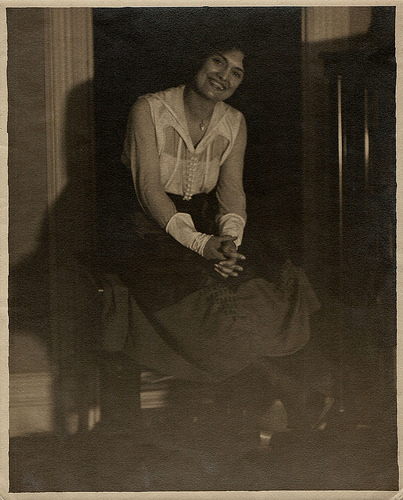
Virginia Rappe. Vintage photo. Collection: Didier Hanson.
The magic and youthful spirit of before
Roscoe Arbuckle tried returning to filmmaking, but industry resistance to distributing his pictures continued to linger after his acquittal. He retreated into alcoholism.
Buster Keaton attempted to help Arbuckle by giving him work on his films. Arbuckle wrote the story for a Keaton short called Day Dreams (Edward F. Cline, Buster Keaton, 1922). Arbuckle allegedly co-directed scenes in Keaton's Sherlock, Jr. (Buster Keaton, 1924), but it is unclear how much of this footage remained in the film's final cut.
In 1925, Carter Dehaven made the short Character Studies (1927) in which Arbuckle appeared alongside Buster Keaton , Harold Lloyd, Rudolph Valentino , Douglas Fairbanks , and Jackie Coogan.
Eventually, Arbuckle was given work as a film director under the alias William Goodrich. Between 1924 and 1932, Arbuckle directed a number of comedy shorts under the pseudonym for Educational Pictures. His films included the Eddie Cantor feature Special Delivery (1927), the Marion Davies vehicle The Red Mill (1927) and Windy Riley Goes Hollywood (1931) with Louise Brooks .
In 1927, he was also engaged to direct and star a series of comedy shorts for producer Abe Carlos. The films were to be shot in Berlin and distributed internationally, and Arbuckle's wife Doris Deane was to star with him. The films were never produced.
In 1929, Doris Deane sued for divorce and Roscoe married Addie Oakley Dukes McPhail in 1931. In 1932, Arbuckle signed a contract with Warner Bros. to star under his own name in a series of two-reel comedies, to be filmed at the Vitagraph studios in Brooklyn. He started with Hey, Pop! (Alfred J. Goulding, 1932).
Tony Fontana at IMDb : “He completed six shorts and showed the magic and youthful spirit that he had a decade before.” These successful films with Al St. John (Arbuckle's nephew) and Lionel Stander constitute the only recordings of his voice. On 28 June 1933, Arbuckle had finished filming the last of the two-reelers and the next day he was signed by Warner Bros. to make a feature-length film.
That night he went out with friends to celebrate his first wedding anniversary and new Warner contract where he reportedly said: "This is the best day of my life." He suffered a heart attack later that night and died in his sleep. Roscoe Arbuckle was 46.
The Butcher Boy (Roscoe Arbuckle, 1917) with Fatty Arbuckle and Buster Keaton . Source: Wm. Thomas Sherman (YouTube).
Sources: (IMDb), Wikipedia and .

German postcard by Ross Verlag, no. 799/2, 1925-1926. Photo: Phoebus Film.

French postcard by Éditions Filma in the Les Vedettes du Cinéma series, no. 80. Photo: Super-Film.
Bowler-hat and pants whose legs were too short
Roscoe Conkling Arbuckle was born in 1887 in Smith Center, Kansas, one of nine children of Mary E. 'Mollie' Gordon and William Goodrich Arbuckle. His family moved to California when he was a year old.
Arbuckle had a wonderful singing voice and was extremely agile. At the age of eight, with his mother's encouragement, he first performed on stage with Frank Bacon's company. Arbuckle enjoyed performing and continued on until his mother's death in 1899 when he was 12.
His father, who had always treated him harshly, now refused to support him and Arbuckle got work doing odd jobs in a hotel. Arbuckle was in the habit of singing while he worked and was overheard by a customer who was a professional singer. The customer invited him to perform in an amateur talent show. He not only won the competition but began a career in vaudeville.
In 1904, Sid Grauman invited Arbuckle to sing illustrated songs in his new Unique Theater in San Francisco. He then joined the Pantages Theatre Group touring the West Coast of the United States and in 1906 played the Orpheum Theater in Portland, Oregon in a vaudeville troupe organised by Leon Errol. Arbuckle became the main act and the group took their show on tour.
In 1908, Arbuckle married Minta Durfee, who later starred in many early comedy films, often with Arbuckle. Arbuckle then joined the Morosco Burbank Stock vaudeville company and went on a tour of China and Japan returning in early 1909.
That year, Arbuckle began his film career with the Selig Polyscope Company when he appeared in Ben's Kid (Francis Boggs, 1909). He appeared sporadically in Selig one-reelers until 1913, moved briefly to Universal Pictures.
Then, Arbuckle went to work in producer-director Mack Sennett's Keystone Cops comedies. His character Fatty – he weighed 135 kilogrammes at the height of his career - usually wore bowler-hat and pants whose legs were too short. For the next 3-1/2 years he appeared in hundreds of one-reel comedies, mostly as policemen, but he also played different parts.
He would work with Mabel Normand, Ford Sterling, among others, and would learn about the process of making films from Henry Lehrman, who directed many of his pictures. Despite his massive physical size, Arbuckle was remarkably agile and acrobatic. His comedies are noted as rollicking and fast-paced, have many chase scenes, and feature sight gags.
Arbuckle was fond of the ‘pie in the face’, a comedy cliche that has come to symbolise silent-film-era comedy itself. The earliest known custard pie thrown in film was in the Keystone one-reeler A Noise from the Deep (Mack Sennett, 1913). The pie was thrown by Mabel Normand and Arbuckle was the recipient.

American postcard by Keystone cards, presented with Home Weekly. Photo: Keystone Film. Publicity still for Fatty's Wine Party (Roscoe 'Fatty' Arbuckle, 1914) with Fatty Arbuckle and Mabel Normand. Caption: A Ticklish Moment.

American postcard by Keystone cards, presented with Home Weekly. Photo: Keystone Film. Publicity still for Fatty's Chance Acquaintance ( Roscoe 'Fatty' Arbuckle, 1915) with Billie Bennett.
A then-unheard-of offer
By 1914 Roscoe Arbuckle had begun directing some of his one-reels. Paramount Pictures made the then-unheard-of offer of US$1,000-a-day plus 25% of all profits and complete artistic control to make films with Arbuckle and Normand.
The next year he had moved up to two-reels, which meant that he would need to sustain the comedy to be successful - as it turned out, he was. Among his films were Fatty Again (Roscoe 'Fatty' Arbuckle, 1914), Mabel, Fatty and the Law (Roscoe 'Fatty' Arbuckle,1915), Mabel and Fatty's Wash Day (Roscoe 'Fatty' Arbuckle, 1915), Mabel and Fatty Viewing the World's Fair at San Francisco (Roscoe 'Fatty' Arbuckle, 1915), Fatty's Reckless Fling (Roscoe 'Fatty' Arbuckle, 1915) with Edgar Kennedy, and many more.
Charles Chaplin assisted Arbuckle in The Knockout (Mack Sennett, 1914); and Harold Lloyd was his co-star in Miss Fatty's Seaside Lovers (Roscoe 'Fatty' Arbuckle, 1915). He also hired a young performer he met in New York by the name of Buster Keaton .
Keaton's film career would start with Roscoe in The Butcher Boy (Roscoe 'Fatty' Arbuckle, 1917). Keaton supported him in at least 14 shorts. The films were so lucrative and popular that in 1918 Paramount offered Arbuckle a three-year, $3 million contract ($48,000,000 in 2016 dollars).
In 1916, Arbuckle had started his own film company, Comique, in partnership with Joseph Schenck. Although Comique produced some of the best short pictures of the silent era, in 1918 Arbuckle transferred his controlling interest in the company to Buster Keaton and accepted Paramount's $3 million offer to make up to 18 feature films over three years.
Roscoe's first feature was the Western comedy The Round-Up (George Melford, 1920) and it was successful. It was soon followed by other features, including Brewster's Millions (Joseph Henabery, 1921) and Gasoline Gus (James Cruze, 1921) with Lila Lee.

French postcard by Edition Paramount, Paris.

Swedish postcard by Forlag Nordisk Konst, Stockholm, no. 865. Photo: Triangle-Keystonefilm.
The Death of Virginia Rappe
On 5 September 1921, Roscoe Arbuckle took a break from his hectic film schedule and, drove to San Francisco with two friends, Lowell Sherman and Fred Fishback. The three checked into three rooms at the St. Francis Hotel. They invited several women to their suite.
During the carousing, a 26-year-old starlet named Virginia Rappe was found seriously ill and was examined by the hotel doctor, who concluded her symptoms were mostly caused by intoxication, and gave her morphine to calm her. Rappe was not hospitalised until two days after the incident.
Virginia Rappe suffered from chronic cystitis, a condition that liquor irritated dramatically. Her heavy drinking habits and the poor quality of the era's bootleg alcohol could leave her in severe physical distress. She had undergone several abortions in the space of a few years, and she was preparing to undergo another.
At the hospital, Rappe's companion at the party, Bambina Maude Delmont, told Rappe's doctor that Arbuckle had raped her friend. The doctor examined Rappe but found no evidence of rape. Rappe died one day after her hospitalization of peritonitis, caused by a ruptured bladder. Delmont then told police that Arbuckle raped Rappe, and the police concluded that the impact Arbuckle's overweight body had on Rappe eventually caused her bladder to rupture. Delmont later made a statement incriminating Arbuckle to the police in an attempt to extort money from Arbuckle's attorneys.
Arbuckle's trial was a major media event; exaggerated and sensationalized stories ran in William Randolph Hearst's nationwide newspaper chain. The resulting scandal destroyed Arbuckle's career and his personal life. In his testimony, Arbuckle denied he had any knowledge of Rappe's illness.
The first trial (14 November-4 December 1921) ended with the jury deadlocked 10 to 2 in favor of acquittal. The second trial (11 January -3 February 1922) also ended in a hung jury; this time the majority had ruled against Roscoe - 10 to 2 for conviction. The third trial (13 March – 12 April 1922) finally ended with an acquittal and a formal statement of apology to Arbuckle for putting him through the ordeal; a dramatic move in American justice.
At the time of his acquittal, Arbuckle owed over $700,000 in legal fees to his attorneys for the three criminal trials, and he was forced to sell his house and all of his cars to pay some of the debt. Although he had been cleared of all criminal charges, the scandal had greatly damaged his popularity among the general public. Will H. Hays banned Roscoe Arbuckle from ever working in U.S. movies again. He had also requested that all showings and bookings of Arbuckle films be canceled.
In December of the same year, under public pressure, Hays elected to lift the ban, but Arbuckle was still unable to secure work as an actor. Buster Keaton signed an agreement to give Arbuckle 35 percent of all future profits from his company, Buster Keaton Productions, to ease his financial situation.
In November 1923, Minta Durfee filed for divorce, charging grounds of desertion. The divorce was granted the following January. Arbuckle married Doris Deane in 1925.

Virginia Rappe. Vintage photo. Collection: Didier Hanson.
The magic and youthful spirit of before
Roscoe Arbuckle tried returning to filmmaking, but industry resistance to distributing his pictures continued to linger after his acquittal. He retreated into alcoholism.
Buster Keaton attempted to help Arbuckle by giving him work on his films. Arbuckle wrote the story for a Keaton short called Day Dreams (Edward F. Cline, Buster Keaton, 1922). Arbuckle allegedly co-directed scenes in Keaton's Sherlock, Jr. (Buster Keaton, 1924), but it is unclear how much of this footage remained in the film's final cut.
In 1925, Carter Dehaven made the short Character Studies (1927) in which Arbuckle appeared alongside Buster Keaton , Harold Lloyd, Rudolph Valentino , Douglas Fairbanks , and Jackie Coogan.
Eventually, Arbuckle was given work as a film director under the alias William Goodrich. Between 1924 and 1932, Arbuckle directed a number of comedy shorts under the pseudonym for Educational Pictures. His films included the Eddie Cantor feature Special Delivery (1927), the Marion Davies vehicle The Red Mill (1927) and Windy Riley Goes Hollywood (1931) with Louise Brooks .
In 1927, he was also engaged to direct and star a series of comedy shorts for producer Abe Carlos. The films were to be shot in Berlin and distributed internationally, and Arbuckle's wife Doris Deane was to star with him. The films were never produced.
In 1929, Doris Deane sued for divorce and Roscoe married Addie Oakley Dukes McPhail in 1931. In 1932, Arbuckle signed a contract with Warner Bros. to star under his own name in a series of two-reel comedies, to be filmed at the Vitagraph studios in Brooklyn. He started with Hey, Pop! (Alfred J. Goulding, 1932).
Tony Fontana at IMDb : “He completed six shorts and showed the magic and youthful spirit that he had a decade before.” These successful films with Al St. John (Arbuckle's nephew) and Lionel Stander constitute the only recordings of his voice. On 28 June 1933, Arbuckle had finished filming the last of the two-reelers and the next day he was signed by Warner Bros. to make a feature-length film.
That night he went out with friends to celebrate his first wedding anniversary and new Warner contract where he reportedly said: "This is the best day of my life." He suffered a heart attack later that night and died in his sleep. Roscoe Arbuckle was 46.
The Butcher Boy (Roscoe Arbuckle, 1917) with Fatty Arbuckle and Buster Keaton . Source: Wm. Thomas Sherman (YouTube).
Sources: (IMDb), Wikipedia and .
Published on September 30, 2017 22:00
September 29, 2017
The Student Prince in Old Heidelberg (1927)
We're so sad that we can't be in Italy to join Le Giornate del Cinema Muto in Pordenone this year. The 36th edition starts today and continues till 7 October. EFSP will do a festival post every day on one of the silent stars or the films than can be seen in Pordenone. We wish director Jay Weissberg good luck on his second edition which has a really delightful programme. Our series starts with a post on the closing event of the festival, Ernst Lubitsch's classic The Student Prince in Old Heidelberg (1927), featuring Ramón Novarro.
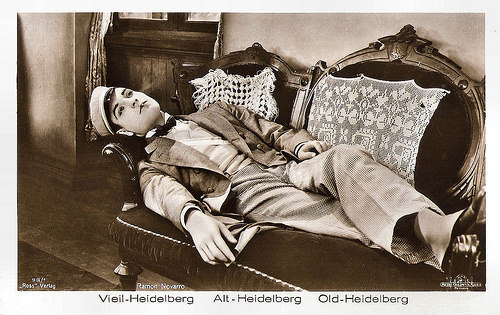
German postcard by Ross Verlag, no. 98/1. Photo: Metro-Goldwyn-Mayer. Publicity still for The Student Prince in Old Heidelberg (Ernst Lubitsch, 1927).
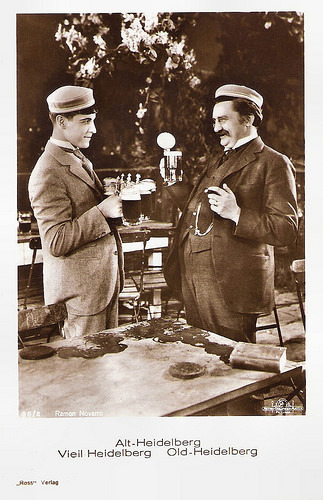
German postcard by Ross Verlag, no. 98/2. Photo: Metro-Goldwyn-Mayer. Publicity still for The Student Prince in Old Heidelberg (Ernst Lubitsch, 1927) with Ramon Novarro and Jean Hersholt.

German postcard by Ross Verlag, no. 98/3. Photo: Metro-Goldwyn-Mayer. Publicity still for The Student Prince in Old Heidelberg (Ernst Lubitsch, 1927).
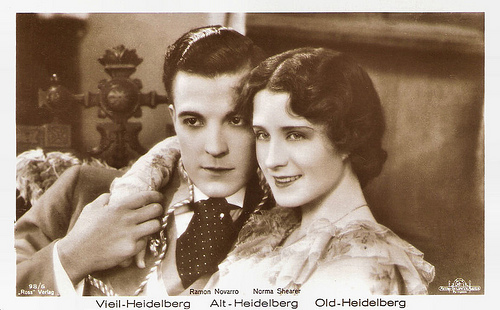
German postcard by Ross Verlag, no. 98/6. Photo: Metro-Goldwyn-Mayer. Publicity still for The Student Prince in Old Heidelberg (Ernst Lubitsch, 1927) with Ramon Novarro and Norma Shearer.
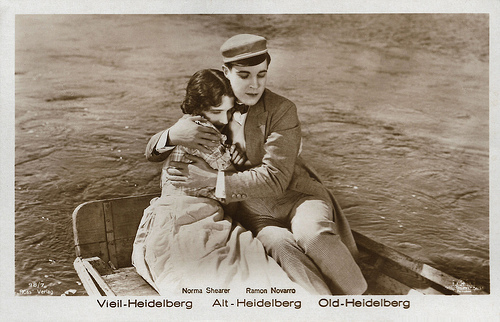
German postcard by Ross Verlag, no. 98/7. Photo: Metro-Goldwyn-Mayer. Publicity still for The Student Prince in Old Heidelberg (Ernst Lubitsch, 1927) with Ramon Novarro and Norma Shearer.
A Viennese fairy tale
The American silent film The Student Prince in Old Heidelberg (1927), also known as The Student Prince, The Student Prince of Old Heidelberg and Old Heidelberg, is a Viennese fairy tale. The Metro-Goldwyn-Mayer production is based on the 1901 play Alt Heidelberg (Old Heidelberg) by Wilhelm Meyer-Förster. The script was written by Hanns Kräly and Karl Heinrich with titles by Marian Ainslee and Ruth Cummings.
MGM's executive producer Irving Thalberg initially planned to have Erich von Stroheim direct this film as a follow-up to the director's commercial success The Merry Widow. Stroheim declined, opting instead to leave MGM and begin work on The Wedding March (1928). Thalberg then tried to attach E.A. Dupont, and then John S. Robertson to the project, but both passed on it. He settled on thirty-four-year-old German émigré Ernst Lubitsch .
Wikipedia serves up the plot in detail: Young Crown Prince Karl Heinrich (Philippe De Lacy), heir to the kingdom of Karlsburg, is brought to live with his stern uncle, King Karl VII (Gustav von Seyffertitz). The king immediately dismisses the boy's nanny (Edythe Chapman) without telling the youngster to avoid an emotional farewell. Fortunately, Dr. Friedrich Jüttner (Jean Hersholt), his new tutor, proves to be sympathetic, and they become lifelong friends. Nonetheless, despite the commoners' belief that it must be wonderful to be him, the boy grows up lonely, without playmates his own age.
Upon passing his high school examination in 1901 with the help of Dr. Jüttner, the young prince ( Ramon Novarro ) is delighted to learn that both he and Jüttner are being sent to Heidelberg, where he will continue his education. When they arrive, Karl's servant is appalled at the rooms provided for the prince and Jüttner at the inn of Ruder (Otis Harlan). When Ruder's niece Kathi (Norma Shearer) stoutly defends the centuries-old family business, Karl is entranced by her, and decides to stay. He is quickly made a member of Corps Saxonia, a student society.
Later that day, Karl tries to kiss Kathi, only to learn that she is engaged. Her family approves of her fiance, but she is not so sure about him. She eventually confesses to Karl that, despite the vast social gulf between them, she has fallen in love with him. Karl feels the same about her and swears that he will let nothing separate them. When he takes her boating, their rower, Johann Kellermann (Bobby Mack), turns his back to them to give them some privacy. Karl jokingly tells him that, when he is king, he will make Kellermann his majordomo.
Then Jüttner receives a letter from the king ordering him to inform Karl that he has selected a princess for him to marry. Jüttner cannot bring himself to destroy his friend's happiness. That same day, however, Prime Minister von Haugk (Edward Connelly) arrives with the news that the king is seriously ill, and that Karl must go home and take up the reins of government. When Karl sees his uncle, he is told of the matrimonial plans. While Karl is still reeling from the shock, the old king dies, followed by Jüttner.
Later, von Haugk presses the new monarch about the marriage. The anguished Karl signs the document for the wedding. Then Kellermann shows up to take the job Karl had offered him. When Karl asks him about Kathi, he learns that she is still waiting for him. He goes to see her one last time. In the last scene, Karl is shown riding through the streets in a carriage with his bride, the princess. One onlooker remarks that it must be wonderful to be king, unaware of Karl's misery.
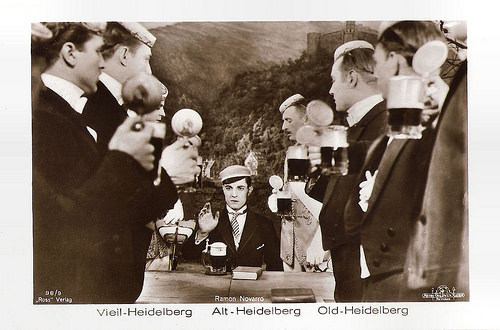
German postcard by Ross Verlag, no. 98/9. Photo: Metro-Goldwyn-Mayer. Publicity still for The Student Prince in Old Heidelberg (Ernst Lubitsch, 1927).
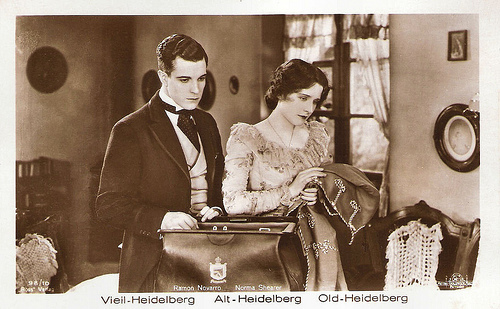
German postcard by Ross Verlag, no. 98/10. Photo: Metro-Goldwyn-Mayer. Publicity still for The Student Prince in Old Heidelberg (Ernst Lubitsch, 1927) with Ramon Novarro and Norma Shearer.
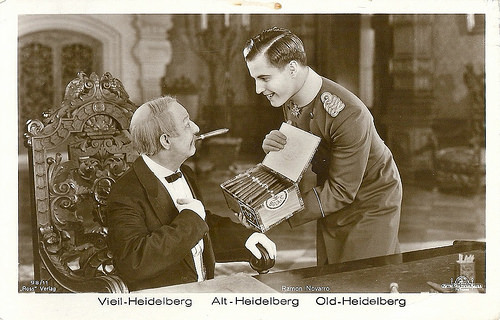
German postcard by Ross Verlag, no. 98/11. Photo: Metro-Goldwyn-Mayer. Publicity still for The Student Prince in Old Heidelberg (Ernst Lubitsch, 1927) with Ramon Novarro and Bobby Mack.
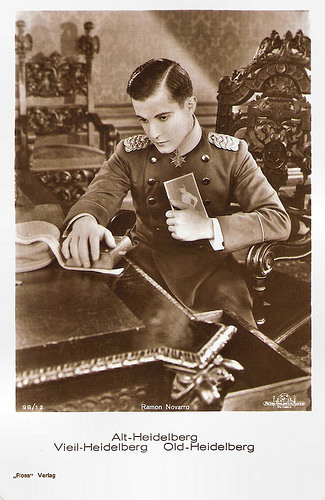
German postcard by Ross Verlag, no. 98/12. Photo: Metro-Goldwyn-Mayer. Publicity still for The Student Prince in Old Heidelberg (Ernst Lubitsch, 1927).
A scintillating example of the artistry of Ernst Lubitsch
Ramon Novarro was cast as the Student Prince after John Gilbert was considered. Ernst Lubitsch felt that both Novarro and Shearer were miscast, but was unable to override the studio's casting decisions. According to Wikipedia , Lubitsch's insistence on multiple takes and minimal rehearsal time were hard on both leads. Shearer even complained to Thalberg, her fiance, about Lubitsch's penchant for acting out scenes for the actors before they were shot. Thalberg told her that "everyone has a lot to learn from Lubitsch."
The love scene in the beer garden, which is acclaimed as one of the best scenes in the film by modern critics, was allegedly a headache for the director, who had it reshot entirely, but was still unhappy with it. It was rumoured that the love scene in the film was reshot by John M. Stahl, but Lubitsch's assistant on the film, Andrew Marton, denied this.
The Student Prince in Old Heidelberg was in production for more than 108 days. The result is a supremely artificial and studio-built film, contrasting the voluminous sets of the Karlsburg Palace with the warmer interiors and exteriors of the Heidelberg taverns and beer gardens. Ernst Lubitsch drove up the budget significantly, infuriating the studio. For instance, he had costume designer Ali Hubert bring thirty-two trunks of wardrobe and props from Europe for use in the film.
Though now considered a classic, it was far from a unanimous critical success during its original theatrical run. In a review for The New York Times , Mordaunt Hall wrote, "Mr. Novarro is natural and earnest, but he is a little too Latin in appearance for the rôle. Norma Shearer is attractive as Kathi. She, however, does not seem to put her soul into the part. She, too, acts well, but, like Mr. Novarro, she does not respond, as other players have done, to Mr. Lubitsch's direction. The ablest acting in this piece of work is done by Jean Hersholt as Dr. Guttner (sic) and Gustav von Seyffertitz as the King. Their efforts in all their scenes reveal their sensitiveness to the direction."
Despite being a popular film with filmgoers, the exorbitant production cost of The Student Prince in Old Heidelberg (IMDb estimates it as $1.205.000) kept it from making a profit. The film lost $307,000, according to Wikipedia .
Today many viewers consider it one of Lubitsch's finest silent films. Adrian Banks at Senses of Cinema : "The Student Prince in Old Heidelberg is one of Lubitsch’s most surprising, nostalgic and emotionally engaging films. It represents a 'return to Germany' after four years in Hollywood, and can be seen as something of a watershed between his initial works for Warner Bros., then a significantly less important studio than it would soon become, and his extraordinary ten or so year tenure at Paramount."
Greg Carleton at IMDb : "I found this film an absolute delight. All of the leads put in outstanding performances. The romance between Prince Karl ( Ramon Novarro ) and Kathi (Norma Shearer) is wonderfully presented, and it is truly poignant." Ron Oliver at IMDb : "This wonderful, exuberant, heartbreaking film - one of the last major movies of the Silent Era - is a scintillating example of the artistry of director Ernst Lubitsch . Filled with wry humor & aching pathos, Lubitsch tells a tale which is a persuasive paean to the power of the talkless film." We totally agree.
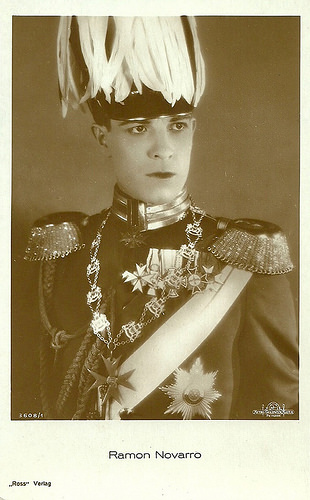
German postcard by Ross Verlag, no. 3608/1, 1928-1929. Photo: Metro-Goldwyn-Mayer. Novarro wears the outfit of The Student Prince in Old Heidelberg (Ernst Lubitsch, 1927) at the end of the film (though it may have been recycled for a later film, as the Ross number suggests).
Trailer The Student Prince in Old Heidelberg (1927). Source: TV Movie Trailer (Daily Motion).
Sources: Adrian Banks (Senses of Cinema), Greg Carleton (IMDb), Ron Oliver (IMDb), Wikipedia and IMDb.

German postcard by Ross Verlag, no. 98/1. Photo: Metro-Goldwyn-Mayer. Publicity still for The Student Prince in Old Heidelberg (Ernst Lubitsch, 1927).

German postcard by Ross Verlag, no. 98/2. Photo: Metro-Goldwyn-Mayer. Publicity still for The Student Prince in Old Heidelberg (Ernst Lubitsch, 1927) with Ramon Novarro and Jean Hersholt.

German postcard by Ross Verlag, no. 98/3. Photo: Metro-Goldwyn-Mayer. Publicity still for The Student Prince in Old Heidelberg (Ernst Lubitsch, 1927).

German postcard by Ross Verlag, no. 98/6. Photo: Metro-Goldwyn-Mayer. Publicity still for The Student Prince in Old Heidelberg (Ernst Lubitsch, 1927) with Ramon Novarro and Norma Shearer.

German postcard by Ross Verlag, no. 98/7. Photo: Metro-Goldwyn-Mayer. Publicity still for The Student Prince in Old Heidelberg (Ernst Lubitsch, 1927) with Ramon Novarro and Norma Shearer.
A Viennese fairy tale
The American silent film The Student Prince in Old Heidelberg (1927), also known as The Student Prince, The Student Prince of Old Heidelberg and Old Heidelberg, is a Viennese fairy tale. The Metro-Goldwyn-Mayer production is based on the 1901 play Alt Heidelberg (Old Heidelberg) by Wilhelm Meyer-Förster. The script was written by Hanns Kräly and Karl Heinrich with titles by Marian Ainslee and Ruth Cummings.
MGM's executive producer Irving Thalberg initially planned to have Erich von Stroheim direct this film as a follow-up to the director's commercial success The Merry Widow. Stroheim declined, opting instead to leave MGM and begin work on The Wedding March (1928). Thalberg then tried to attach E.A. Dupont, and then John S. Robertson to the project, but both passed on it. He settled on thirty-four-year-old German émigré Ernst Lubitsch .
Wikipedia serves up the plot in detail: Young Crown Prince Karl Heinrich (Philippe De Lacy), heir to the kingdom of Karlsburg, is brought to live with his stern uncle, King Karl VII (Gustav von Seyffertitz). The king immediately dismisses the boy's nanny (Edythe Chapman) without telling the youngster to avoid an emotional farewell. Fortunately, Dr. Friedrich Jüttner (Jean Hersholt), his new tutor, proves to be sympathetic, and they become lifelong friends. Nonetheless, despite the commoners' belief that it must be wonderful to be him, the boy grows up lonely, without playmates his own age.
Upon passing his high school examination in 1901 with the help of Dr. Jüttner, the young prince ( Ramon Novarro ) is delighted to learn that both he and Jüttner are being sent to Heidelberg, where he will continue his education. When they arrive, Karl's servant is appalled at the rooms provided for the prince and Jüttner at the inn of Ruder (Otis Harlan). When Ruder's niece Kathi (Norma Shearer) stoutly defends the centuries-old family business, Karl is entranced by her, and decides to stay. He is quickly made a member of Corps Saxonia, a student society.
Later that day, Karl tries to kiss Kathi, only to learn that she is engaged. Her family approves of her fiance, but she is not so sure about him. She eventually confesses to Karl that, despite the vast social gulf between them, she has fallen in love with him. Karl feels the same about her and swears that he will let nothing separate them. When he takes her boating, their rower, Johann Kellermann (Bobby Mack), turns his back to them to give them some privacy. Karl jokingly tells him that, when he is king, he will make Kellermann his majordomo.
Then Jüttner receives a letter from the king ordering him to inform Karl that he has selected a princess for him to marry. Jüttner cannot bring himself to destroy his friend's happiness. That same day, however, Prime Minister von Haugk (Edward Connelly) arrives with the news that the king is seriously ill, and that Karl must go home and take up the reins of government. When Karl sees his uncle, he is told of the matrimonial plans. While Karl is still reeling from the shock, the old king dies, followed by Jüttner.
Later, von Haugk presses the new monarch about the marriage. The anguished Karl signs the document for the wedding. Then Kellermann shows up to take the job Karl had offered him. When Karl asks him about Kathi, he learns that she is still waiting for him. He goes to see her one last time. In the last scene, Karl is shown riding through the streets in a carriage with his bride, the princess. One onlooker remarks that it must be wonderful to be king, unaware of Karl's misery.

German postcard by Ross Verlag, no. 98/9. Photo: Metro-Goldwyn-Mayer. Publicity still for The Student Prince in Old Heidelberg (Ernst Lubitsch, 1927).

German postcard by Ross Verlag, no. 98/10. Photo: Metro-Goldwyn-Mayer. Publicity still for The Student Prince in Old Heidelberg (Ernst Lubitsch, 1927) with Ramon Novarro and Norma Shearer.

German postcard by Ross Verlag, no. 98/11. Photo: Metro-Goldwyn-Mayer. Publicity still for The Student Prince in Old Heidelberg (Ernst Lubitsch, 1927) with Ramon Novarro and Bobby Mack.

German postcard by Ross Verlag, no. 98/12. Photo: Metro-Goldwyn-Mayer. Publicity still for The Student Prince in Old Heidelberg (Ernst Lubitsch, 1927).
A scintillating example of the artistry of Ernst Lubitsch
Ramon Novarro was cast as the Student Prince after John Gilbert was considered. Ernst Lubitsch felt that both Novarro and Shearer were miscast, but was unable to override the studio's casting decisions. According to Wikipedia , Lubitsch's insistence on multiple takes and minimal rehearsal time were hard on both leads. Shearer even complained to Thalberg, her fiance, about Lubitsch's penchant for acting out scenes for the actors before they were shot. Thalberg told her that "everyone has a lot to learn from Lubitsch."
The love scene in the beer garden, which is acclaimed as one of the best scenes in the film by modern critics, was allegedly a headache for the director, who had it reshot entirely, but was still unhappy with it. It was rumoured that the love scene in the film was reshot by John M. Stahl, but Lubitsch's assistant on the film, Andrew Marton, denied this.
The Student Prince in Old Heidelberg was in production for more than 108 days. The result is a supremely artificial and studio-built film, contrasting the voluminous sets of the Karlsburg Palace with the warmer interiors and exteriors of the Heidelberg taverns and beer gardens. Ernst Lubitsch drove up the budget significantly, infuriating the studio. For instance, he had costume designer Ali Hubert bring thirty-two trunks of wardrobe and props from Europe for use in the film.
Though now considered a classic, it was far from a unanimous critical success during its original theatrical run. In a review for The New York Times , Mordaunt Hall wrote, "Mr. Novarro is natural and earnest, but he is a little too Latin in appearance for the rôle. Norma Shearer is attractive as Kathi. She, however, does not seem to put her soul into the part. She, too, acts well, but, like Mr. Novarro, she does not respond, as other players have done, to Mr. Lubitsch's direction. The ablest acting in this piece of work is done by Jean Hersholt as Dr. Guttner (sic) and Gustav von Seyffertitz as the King. Their efforts in all their scenes reveal their sensitiveness to the direction."
Despite being a popular film with filmgoers, the exorbitant production cost of The Student Prince in Old Heidelberg (IMDb estimates it as $1.205.000) kept it from making a profit. The film lost $307,000, according to Wikipedia .
Today many viewers consider it one of Lubitsch's finest silent films. Adrian Banks at Senses of Cinema : "The Student Prince in Old Heidelberg is one of Lubitsch’s most surprising, nostalgic and emotionally engaging films. It represents a 'return to Germany' after four years in Hollywood, and can be seen as something of a watershed between his initial works for Warner Bros., then a significantly less important studio than it would soon become, and his extraordinary ten or so year tenure at Paramount."
Greg Carleton at IMDb : "I found this film an absolute delight. All of the leads put in outstanding performances. The romance between Prince Karl ( Ramon Novarro ) and Kathi (Norma Shearer) is wonderfully presented, and it is truly poignant." Ron Oliver at IMDb : "This wonderful, exuberant, heartbreaking film - one of the last major movies of the Silent Era - is a scintillating example of the artistry of director Ernst Lubitsch . Filled with wry humor & aching pathos, Lubitsch tells a tale which is a persuasive paean to the power of the talkless film." We totally agree.

German postcard by Ross Verlag, no. 3608/1, 1928-1929. Photo: Metro-Goldwyn-Mayer. Novarro wears the outfit of The Student Prince in Old Heidelberg (Ernst Lubitsch, 1927) at the end of the film (though it may have been recycled for a later film, as the Ross number suggests).
Trailer The Student Prince in Old Heidelberg (1927). Source: TV Movie Trailer (Daily Motion).
Sources: Adrian Banks (Senses of Cinema), Greg Carleton (IMDb), Ron Oliver (IMDb), Wikipedia and IMDb.
Published on September 29, 2017 22:00
September 28, 2017
Dood water (1934)
Every year during the last week of September, Utrecht is the Dutch capital of film. This is the time of the Netherlands Film Festival (NFF), and traditionally EFSP organises its own Unofficial Netherlands Film Star Postcard Festival. Today we present one of the most remarkable Dutch films of the 1930s. Dood water/Dead Water (1934) re-enacts the historical closing of the Zuiderzee (Southern Sea) between 1927 and 1932. The award winning drama was directed and co-written by Gerard Rutten and starred renowned Dutch stage actor Jan Musch as a doomed fisherman.
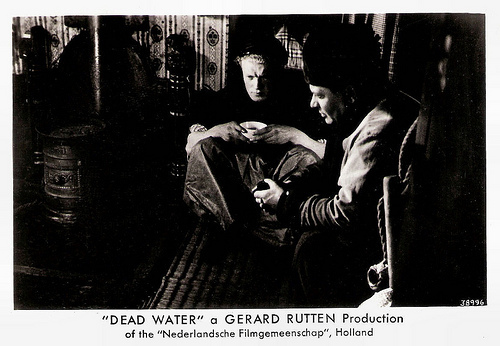
Dutch postcard, no. 38996. Photo: Nederlandse Filmgemeenschap, Holland. Publicity still for Dood water/Dead water (1934) with Max Croiset and Arnold Marlé. Collection: Geoffrey Donaldson Institute.
Dead Water
The social drama Dood water/Dead Water (Gerard Rutten, 1934) opens with a prologue about the Netherlands' everlasting battle against the sea and the history of the Afsluitdijk ('enclosure dam'). It's accompanied by music played by the Amsterdam Concertgebouworkest led by conductor Willem Mengelberg.
Dood water/Dead Water tells about a conflict between young and old fishermen in the little village of Volendam about the fishing in the Zuiderzee (the former Southern Sea, now IJsselmeer).
In 1927, the construction of the Afsluitdijk (the enclosure dam which made a lake of the Zuiderzee) was started. In Volendam, there is talk of 'dead water' and people realise that everything will not be like it was.
Fisherman Dirk Brak (Arnold Marlé) encourages his son Jan (Max Croiset) to become a farmer, but his brother-in-law, fisherman Willem de Geus ( Jan Musch ), wants radical action against the Afsluitdijk while his helper Jaap (Theo de Maal) recognises the opportunities that land reclamation brings.
Jaap becomes a civil servant, an act which makes him a traitor in the eyes of the villagers. Desperately, the old Willem de Geus tries to blow up the dam, but he dies during the explosion. The 30,000-meter-long Afsluitdijk was ready on 28 May 1932.
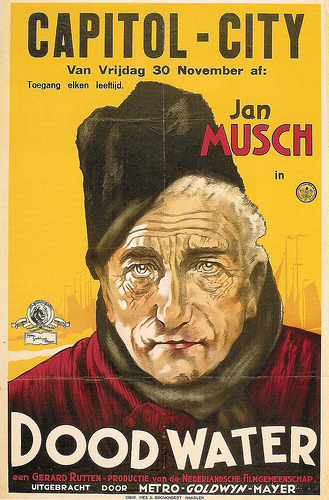
Dutch poster for Dood water/Dead Water (Gerard Rutten, 1934).
Golden Lion
Dood water/Dead Water was largely shot on location, using natural light. The cameraman was Andor von Barsy, a respected Hungarian-Austrian cinematographer who’d already been successful in the Netherlands with short avant-garde films such as Hoogstraat/High street (Andor von Barsy, 1929) about a Rotterdam shopping street.
At the second edition of the Venice Film Festival (Mostra Internazionale d'Arte Cinematografica) in 1934, the film won a Golden Lion for Best Cinematography.
Dood water received favourable reviews in the Italian press, and later also in the Netherlands. There was a German spoken version. Totes Wasser, the only Dutch feature film from the 1930s that reached the German cinemas. The film was very well received in Germany. Goebbels reportedly used Totes Wasser as a compulsory teaching material for German film students.
Writing for the British The Spectator, Graham Greene praised the film's documentary prologue as "an exciting piece of pure cinema", and commented that the story which follows "has some of the magnificent drive one felt behind the classic Russian films, behind Earth and The General Line: no tiresome 'message', but a belief in the importance of a human activity truthfully reported". Greene also noted, however, that "the photography is uneven: at moments it is painfully 'arty', deliberately out of focus"
MGM distributed the low-budget production internationally. However, the film was not a commercial success.

Jan Musch . Dutch postcard by REB in the series Portrettengalerij, no. 105.
One of the great stars
The leading actor of Dood water, Jan Musch (1875-1960), was one of the great stars of the Dutch theatre during the first decades of the 20th Century.
In the 1930s, he starred in a few Dutch films, including De Man zonder hart/The Man Without a Heart (Leo Joannon, 1937), and the thriller De spooktrein/The Ghost Train (Carl Lamac, 1939) with Fien de la Mar .
After the war, Gerard Rutten directed successful light entertainment films like Sterren stralen overal/Stars Twinkle Everywhere (Gerard Rutten, 1953), about a struggling taxi driver (Johan Kaart) who dreams of emigrating to Australia, and Het wonderlijke leven van Willem Parel/The Wondrous life of Willem Parel (Gerard Rutten, 1955) with comedia Wim Sonneveld who has enough of his most popular character, Willem Parel the organ grinder, and tries to get rid of him
Less successful was his De vliegende Hollander/The Flying Dutchman (Gerard Rutten, 1957), about the early life of Dutch aircraft manufacturer Anthony Fokker. Rutten could only make one more film, Wederzijds (Gerard Rutten, 1963), a documentary about Queen Wilhelmina. He died in 1982 at the age of 79.
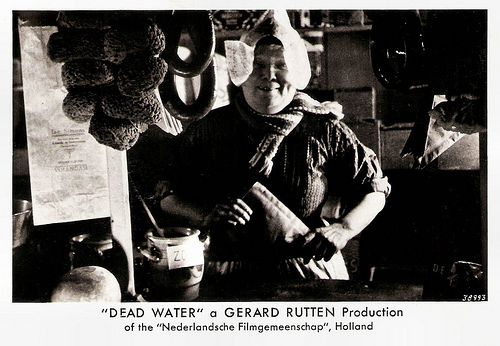
Dutch postcard, no. 38993. Photo: Nederlandse Filmgemeenschap, Holland. Publicity still for Dood water/Dead water (1934). Collection: Geoffrey Donaldson Institute.
Sources: Eye Film, Filmtotaal (Dutch), Movie Meter (Dutch), Wikipedia (Dutch and English) and IMDb.

Dutch postcard, no. 38996. Photo: Nederlandse Filmgemeenschap, Holland. Publicity still for Dood water/Dead water (1934) with Max Croiset and Arnold Marlé. Collection: Geoffrey Donaldson Institute.
Dead Water
The social drama Dood water/Dead Water (Gerard Rutten, 1934) opens with a prologue about the Netherlands' everlasting battle against the sea and the history of the Afsluitdijk ('enclosure dam'). It's accompanied by music played by the Amsterdam Concertgebouworkest led by conductor Willem Mengelberg.
Dood water/Dead Water tells about a conflict between young and old fishermen in the little village of Volendam about the fishing in the Zuiderzee (the former Southern Sea, now IJsselmeer).
In 1927, the construction of the Afsluitdijk (the enclosure dam which made a lake of the Zuiderzee) was started. In Volendam, there is talk of 'dead water' and people realise that everything will not be like it was.
Fisherman Dirk Brak (Arnold Marlé) encourages his son Jan (Max Croiset) to become a farmer, but his brother-in-law, fisherman Willem de Geus ( Jan Musch ), wants radical action against the Afsluitdijk while his helper Jaap (Theo de Maal) recognises the opportunities that land reclamation brings.
Jaap becomes a civil servant, an act which makes him a traitor in the eyes of the villagers. Desperately, the old Willem de Geus tries to blow up the dam, but he dies during the explosion. The 30,000-meter-long Afsluitdijk was ready on 28 May 1932.

Dutch poster for Dood water/Dead Water (Gerard Rutten, 1934).
Golden Lion
Dood water/Dead Water was largely shot on location, using natural light. The cameraman was Andor von Barsy, a respected Hungarian-Austrian cinematographer who’d already been successful in the Netherlands with short avant-garde films such as Hoogstraat/High street (Andor von Barsy, 1929) about a Rotterdam shopping street.
At the second edition of the Venice Film Festival (Mostra Internazionale d'Arte Cinematografica) in 1934, the film won a Golden Lion for Best Cinematography.
Dood water received favourable reviews in the Italian press, and later also in the Netherlands. There was a German spoken version. Totes Wasser, the only Dutch feature film from the 1930s that reached the German cinemas. The film was very well received in Germany. Goebbels reportedly used Totes Wasser as a compulsory teaching material for German film students.
Writing for the British The Spectator, Graham Greene praised the film's documentary prologue as "an exciting piece of pure cinema", and commented that the story which follows "has some of the magnificent drive one felt behind the classic Russian films, behind Earth and The General Line: no tiresome 'message', but a belief in the importance of a human activity truthfully reported". Greene also noted, however, that "the photography is uneven: at moments it is painfully 'arty', deliberately out of focus"
MGM distributed the low-budget production internationally. However, the film was not a commercial success.

Jan Musch . Dutch postcard by REB in the series Portrettengalerij, no. 105.
One of the great stars
The leading actor of Dood water, Jan Musch (1875-1960), was one of the great stars of the Dutch theatre during the first decades of the 20th Century.
In the 1930s, he starred in a few Dutch films, including De Man zonder hart/The Man Without a Heart (Leo Joannon, 1937), and the thriller De spooktrein/The Ghost Train (Carl Lamac, 1939) with Fien de la Mar .
After the war, Gerard Rutten directed successful light entertainment films like Sterren stralen overal/Stars Twinkle Everywhere (Gerard Rutten, 1953), about a struggling taxi driver (Johan Kaart) who dreams of emigrating to Australia, and Het wonderlijke leven van Willem Parel/The Wondrous life of Willem Parel (Gerard Rutten, 1955) with comedia Wim Sonneveld who has enough of his most popular character, Willem Parel the organ grinder, and tries to get rid of him
Less successful was his De vliegende Hollander/The Flying Dutchman (Gerard Rutten, 1957), about the early life of Dutch aircraft manufacturer Anthony Fokker. Rutten could only make one more film, Wederzijds (Gerard Rutten, 1963), a documentary about Queen Wilhelmina. He died in 1982 at the age of 79.

Dutch postcard, no. 38993. Photo: Nederlandse Filmgemeenschap, Holland. Publicity still for Dood water/Dead water (1934). Collection: Geoffrey Donaldson Institute.
Sources: Eye Film, Filmtotaal (Dutch), Movie Meter (Dutch), Wikipedia (Dutch and English) and IMDb.
Published on September 28, 2017 22:00
September 27, 2017
Sylvain Poons
During the Netherlands Film Festival, EFSP presents the Unofficial Dutch Film Star Postcards Festival. Today's subject is Sylvain Poons (1896-1985). This Jewish actor and singer from Amsterdam appeared in many popular Dutch musical films from the 1930s. After the war he sang a famous duet with the then 14-year-old Oetze Verschoor, the sad fisher ballad Zuiderzeeballade. It became an evergreen of the Dutch pop music.
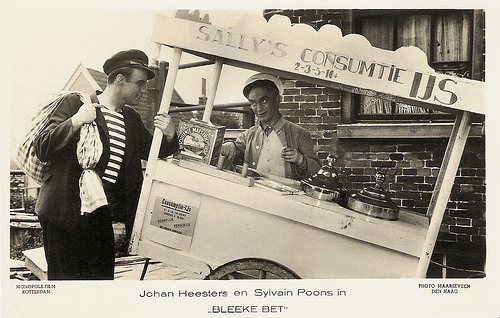
Dutch postcard by Monopole Film, Amsterdam. Photo: Maarseveen, Den Haag. Sylvain Poons and Johan Heesters in the Dutch tragicomedy Bleeke Bet (Richard Oswald, Alex Benno, 1934). Collection: Geoffrey Donaldson Institute.
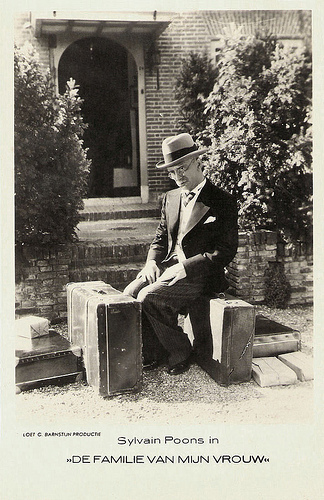
Dutch postcard by M. B.& Z. (M. Bonnist & Zonen, Amsterdam). Photo: Loet C. Barnstijn Productie. Still for De familie van mijn vrouw/My Wife's Family (Jaap Speyer, 1935).
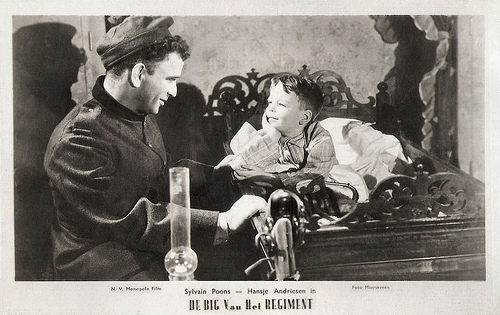
Dutch postcard by Drukkery Joh. Mulder, Gouda for Victoria Bioscoop. Photo: Dick van Maarseveen / N.V. Monopole Film. Still for De Big van het Regiment/The Darling of the Regiment (Max Nosseck, 1935) with Sylvain Poons and Hansje Andriesen.
Natural Way of Acting
Sylvain Albert Poons was born in Amsterdam, The Netherlands in 1896. As the son of the singer Salomon Poons and the actress Elise van Biene, he was destined to become an artist, like his elder sister Fanny Ella, who became known as Fanny Lohoff-Poons.
Sylvain debuted as a stage extra in the season of 1912-1913 for Colnot & Poons, a company named after the two directors of the Plantage Schouwburg (Plantage Theatre): Guus Colnot and Salomon Poons, Sylvain’s father. He played in operettas and variety shows and once in a while he appeared in a ‘serious’ role.
Poons also worked for the early Dutch cinema. He appeared in silent films as Levensschaduwen/ Life's Shadows (Theo Frenkel, 1916), De Duivel/The Devil (Theo Frenkel, 1918), Het Proces Begeer/The Begeer Case (Theo Frenkel, 1918) and Moderne Landhaaien/Modern Land Sharks (Alex Benno, 1926).
Poons was remarked for his natural way of acting. With Henriëtte ‘Heintje’ Davids he played in the early Belgian sound film Jeunes filles en liberté/Young Girls in Freedom (Fritz Kramp, 1933).
Poons also appeared in one of the first Dutch sound films, De Jantjes/The Tars (Jaap Speyer, 1934). This musical film was an enormous box office hit and starred popular Dutch stage stars as Fien de la Mar , Heintje Davids and Louis Davids, Heintje's even more popular brother. In the film, Poons sings a song with Heintje, Omdat ik zoveel van je hou (Because I Love You So). It became a classic duet and the success of De Jantjes created a wave of Dutch sound films.
That same year, Poons appeared as the smart ice-cream man Sally in Bleeke Bet/Pale Beth (Alex Benno, Richard Oswald, 1934) with Corry Vonk and Johannes Heesters . Other films in which he appeared were De Familie Van Mijn Vrouw/My Wife’s Family (Jaap Speyer, 1935), De Big Van Het Regiment/The Big of the Regiment (Max Nosseck, 1935) with Frits van Dongen a.k.a. Philip Dorn, Kermisgasten/Carnival People (Jaap Speyer, 1936) with Johan Kaart, and Oranje Hein/Orange Hein (Max Nosseck, 1936) with Herman and Aaf Bouber .
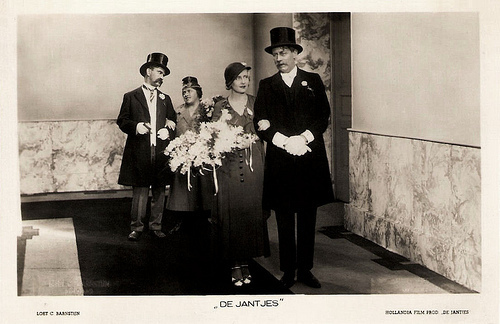
Dutch postcard. Photo: Loet C. Barnstijn/Hollandia Film Prod. Publicity still for De Jantjes (1934), Sylvain Poons together with Heintje Davids in the background.

Dutch postcard by Hollandia Film Prod./Loet C. Barnstijn. Photo: publicity still for De Jantjes (1934) with Johan Kaart , Suzy Klein, Willy Castello, Heintje Davids , Jan van Ees and Sylvain Poons. Collection: Geoffrey Donaldson Institute.
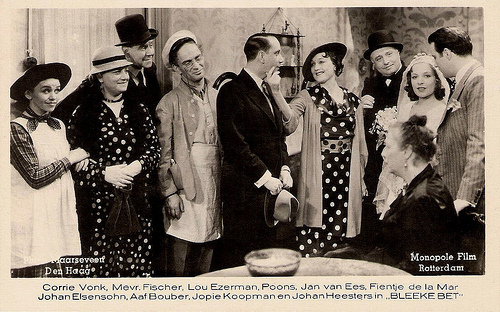
Dutch Postcard by Monopole Film, Rotterdam. Photo: Dick van Maarseveen, Den Haag (The Hague). Publicity still for Bleeke Bet (1934), fourth from left Sylvain Poons.
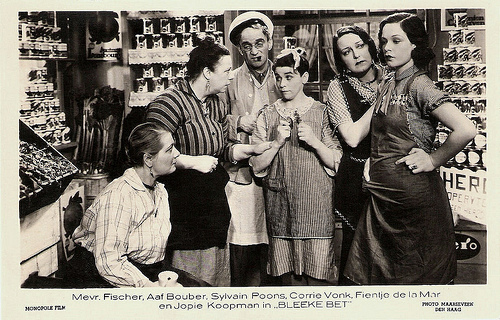
Dutch postcard by Monopole Film, Amsterdam. Photo: Maarseveen, Den Haag. Clara Vischer-Blaaser, Aaf Bouber , Sylvain Poons, Corry Vonk , Fien de la Mar and Jopie Koopman in the Dutch tragicomedy Bleeke Bet (Richard Oswald, Alex Benno, 1934).
Hiding Place
During the Second World War, Sylvain Poons was a member of the Joodsch Kleinkunstensemble (Jewish Variety Company). They performed in the Hollandse Schouwburg (Dutch Theatre) in Amsterdam, which was renamed Joodsche Schouwburg (Jewish Theatre). When it was no longer save for Jews, he fled into a hiding place.
After the liberation he appeared again in a lot of plays on stage and on TV. For a long time he was a permanent member of the radio actors company.
He also appeared in some films, such as the Belgian-German crime film Le Banquet des Fraudeurs/The Smugglers' Banquet (Henri Storck, 1952) with Françoise Rosay . He also played supporting parts in the Dutch films Vier Jongens en een Jeep/Four Boys and a Jeep (Ernst Winar, 1955) and Fietsen Naar De Maan/Cycling to the Moon (Jef van der Heyden, 1963).
He had a huge hit with his duet De Zuiderzeeballade (The Southern Sea Ballad, 1959), sung with the 14-year-old Oetze Verschoor as an old man and his grandson. The record became gold (more than 100,000 records were sold). Poons also recorded several Jewish songs and classics from his pre-war film musicals, including Sally met de roomijskar from Bleeke Bet (1934) and his classic duet with Heintje Davids from De Jantjes (1934), Omdat ik zoveel van je hou.
In later life, he often played the Jewish schlemiel, like his character Abraham Mossel in the popular TV series De kleine waarheid/The Little White Lie (Willy van Hemert, 1971-1972) starring singer Willeke Alberti in her acting debut.
His final stage play was the comedy Getrouwd of niet? (Black on White) by Ephraim Kishon in 1967/1968, which also marked his 50 years Jubilee in the theatre. In 1973 he had to retire because of bad health.
Later, he was made Knight in the Order of Orange-Nassau. After the death of his wife Ilse Becker, he lived the last years of his life in an elderly home in Amsterdam. Sylvain Poons died in 1985, 89 years old.
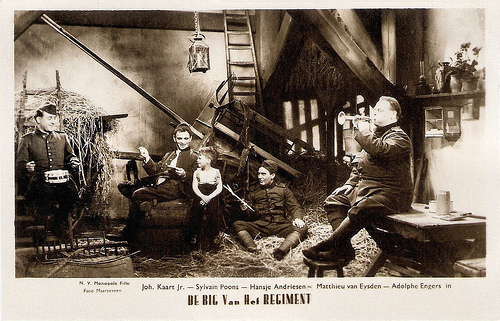
Dutch postcard by Monopole Film N.V. Photo: Dick van Maarseveen. Still for De Big van het Regiment (Max Nosseck, 1935) with Johan Kaart , Sylvain Poons, Hansje Andriesen, Matthieu van Eysden, and Adolphe Engers . Collection: Geoffrey Donaldson Institute.

Dutch postcard by M. B.& Z. (M. Bonnist & Zonen, Amsterdam). Photo: Loet C. Barnstijn Film. Still for De familie van mijn vrouw (Jaap Speyer, 1935) with Loesje Bouwmeester , Gusta Chrispijn-Mulder , Sylvain Poons and Tilly Perin-Bouwmeester.
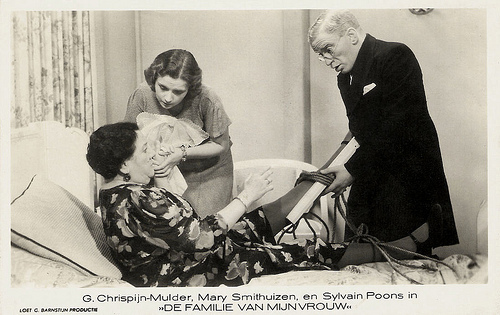
Dutch postcard by M. B.& Z. (M. Bonnist & Zonen, Amsterdam). Photo: Loet C. Barnstijn Productie. Publiciry still for De familie van mijn vrouw/My Wife's Family (1935) with Mary Smithuysen and Gusta Chrispijn-Mulder .
Sylvain Poons and Heintje Davids sing Omdat ik zoveel van je hou in De Jantjes (Jaap Speyer, 1934). Source: Pieteroyama (YouTube).
Sylvain Poons sings Draaien, altijd maar draaien in the TV show Top of Flop. Source: Levi1955 (YouTube).
Sources: Muziekencyclopedie.nl (Dutch), Wikipedia (Dutch) and .

Dutch postcard by Monopole Film, Amsterdam. Photo: Maarseveen, Den Haag. Sylvain Poons and Johan Heesters in the Dutch tragicomedy Bleeke Bet (Richard Oswald, Alex Benno, 1934). Collection: Geoffrey Donaldson Institute.

Dutch postcard by M. B.& Z. (M. Bonnist & Zonen, Amsterdam). Photo: Loet C. Barnstijn Productie. Still for De familie van mijn vrouw/My Wife's Family (Jaap Speyer, 1935).

Dutch postcard by Drukkery Joh. Mulder, Gouda for Victoria Bioscoop. Photo: Dick van Maarseveen / N.V. Monopole Film. Still for De Big van het Regiment/The Darling of the Regiment (Max Nosseck, 1935) with Sylvain Poons and Hansje Andriesen.
Natural Way of Acting
Sylvain Albert Poons was born in Amsterdam, The Netherlands in 1896. As the son of the singer Salomon Poons and the actress Elise van Biene, he was destined to become an artist, like his elder sister Fanny Ella, who became known as Fanny Lohoff-Poons.
Sylvain debuted as a stage extra in the season of 1912-1913 for Colnot & Poons, a company named after the two directors of the Plantage Schouwburg (Plantage Theatre): Guus Colnot and Salomon Poons, Sylvain’s father. He played in operettas and variety shows and once in a while he appeared in a ‘serious’ role.
Poons also worked for the early Dutch cinema. He appeared in silent films as Levensschaduwen/ Life's Shadows (Theo Frenkel, 1916), De Duivel/The Devil (Theo Frenkel, 1918), Het Proces Begeer/The Begeer Case (Theo Frenkel, 1918) and Moderne Landhaaien/Modern Land Sharks (Alex Benno, 1926).
Poons was remarked for his natural way of acting. With Henriëtte ‘Heintje’ Davids he played in the early Belgian sound film Jeunes filles en liberté/Young Girls in Freedom (Fritz Kramp, 1933).
Poons also appeared in one of the first Dutch sound films, De Jantjes/The Tars (Jaap Speyer, 1934). This musical film was an enormous box office hit and starred popular Dutch stage stars as Fien de la Mar , Heintje Davids and Louis Davids, Heintje's even more popular brother. In the film, Poons sings a song with Heintje, Omdat ik zoveel van je hou (Because I Love You So). It became a classic duet and the success of De Jantjes created a wave of Dutch sound films.
That same year, Poons appeared as the smart ice-cream man Sally in Bleeke Bet/Pale Beth (Alex Benno, Richard Oswald, 1934) with Corry Vonk and Johannes Heesters . Other films in which he appeared were De Familie Van Mijn Vrouw/My Wife’s Family (Jaap Speyer, 1935), De Big Van Het Regiment/The Big of the Regiment (Max Nosseck, 1935) with Frits van Dongen a.k.a. Philip Dorn, Kermisgasten/Carnival People (Jaap Speyer, 1936) with Johan Kaart, and Oranje Hein/Orange Hein (Max Nosseck, 1936) with Herman and Aaf Bouber .

Dutch postcard. Photo: Loet C. Barnstijn/Hollandia Film Prod. Publicity still for De Jantjes (1934), Sylvain Poons together with Heintje Davids in the background.

Dutch postcard by Hollandia Film Prod./Loet C. Barnstijn. Photo: publicity still for De Jantjes (1934) with Johan Kaart , Suzy Klein, Willy Castello, Heintje Davids , Jan van Ees and Sylvain Poons. Collection: Geoffrey Donaldson Institute.

Dutch Postcard by Monopole Film, Rotterdam. Photo: Dick van Maarseveen, Den Haag (The Hague). Publicity still for Bleeke Bet (1934), fourth from left Sylvain Poons.

Dutch postcard by Monopole Film, Amsterdam. Photo: Maarseveen, Den Haag. Clara Vischer-Blaaser, Aaf Bouber , Sylvain Poons, Corry Vonk , Fien de la Mar and Jopie Koopman in the Dutch tragicomedy Bleeke Bet (Richard Oswald, Alex Benno, 1934).
Hiding Place
During the Second World War, Sylvain Poons was a member of the Joodsch Kleinkunstensemble (Jewish Variety Company). They performed in the Hollandse Schouwburg (Dutch Theatre) in Amsterdam, which was renamed Joodsche Schouwburg (Jewish Theatre). When it was no longer save for Jews, he fled into a hiding place.
After the liberation he appeared again in a lot of plays on stage and on TV. For a long time he was a permanent member of the radio actors company.
He also appeared in some films, such as the Belgian-German crime film Le Banquet des Fraudeurs/The Smugglers' Banquet (Henri Storck, 1952) with Françoise Rosay . He also played supporting parts in the Dutch films Vier Jongens en een Jeep/Four Boys and a Jeep (Ernst Winar, 1955) and Fietsen Naar De Maan/Cycling to the Moon (Jef van der Heyden, 1963).
He had a huge hit with his duet De Zuiderzeeballade (The Southern Sea Ballad, 1959), sung with the 14-year-old Oetze Verschoor as an old man and his grandson. The record became gold (more than 100,000 records were sold). Poons also recorded several Jewish songs and classics from his pre-war film musicals, including Sally met de roomijskar from Bleeke Bet (1934) and his classic duet with Heintje Davids from De Jantjes (1934), Omdat ik zoveel van je hou.
In later life, he often played the Jewish schlemiel, like his character Abraham Mossel in the popular TV series De kleine waarheid/The Little White Lie (Willy van Hemert, 1971-1972) starring singer Willeke Alberti in her acting debut.
His final stage play was the comedy Getrouwd of niet? (Black on White) by Ephraim Kishon in 1967/1968, which also marked his 50 years Jubilee in the theatre. In 1973 he had to retire because of bad health.
Later, he was made Knight in the Order of Orange-Nassau. After the death of his wife Ilse Becker, he lived the last years of his life in an elderly home in Amsterdam. Sylvain Poons died in 1985, 89 years old.

Dutch postcard by Monopole Film N.V. Photo: Dick van Maarseveen. Still for De Big van het Regiment (Max Nosseck, 1935) with Johan Kaart , Sylvain Poons, Hansje Andriesen, Matthieu van Eysden, and Adolphe Engers . Collection: Geoffrey Donaldson Institute.

Dutch postcard by M. B.& Z. (M. Bonnist & Zonen, Amsterdam). Photo: Loet C. Barnstijn Film. Still for De familie van mijn vrouw (Jaap Speyer, 1935) with Loesje Bouwmeester , Gusta Chrispijn-Mulder , Sylvain Poons and Tilly Perin-Bouwmeester.

Dutch postcard by M. B.& Z. (M. Bonnist & Zonen, Amsterdam). Photo: Loet C. Barnstijn Productie. Publiciry still for De familie van mijn vrouw/My Wife's Family (1935) with Mary Smithuysen and Gusta Chrispijn-Mulder .
Sylvain Poons and Heintje Davids sing Omdat ik zoveel van je hou in De Jantjes (Jaap Speyer, 1934). Source: Pieteroyama (YouTube).
Sylvain Poons sings Draaien, altijd maar draaien in the TV show Top of Flop. Source: Levi1955 (YouTube).
Sources: Muziekencyclopedie.nl (Dutch), Wikipedia (Dutch) and .
Published on September 27, 2017 22:00
Jan Tříska (1936-2017)
Last Monday, 25 September 2017, Czech actor Jan Tříska (1936-2017) died, more than a day after falling from Prague's iconic Charles Bridge. After an impressive career in the European cinema, he was forced to leave Communist Czechoslovakia and emigrated to California. There he appeared in such films as The Karate Kid Part III (1989) and Milos Forman's The People vs Larry Flynt (1996), but he later did his most interesting film work in the Czech Republic, such as in Jan Svankmayer’s macabre, bizarre animation film Sílení/Lunacy (2005). Tříska was 80.
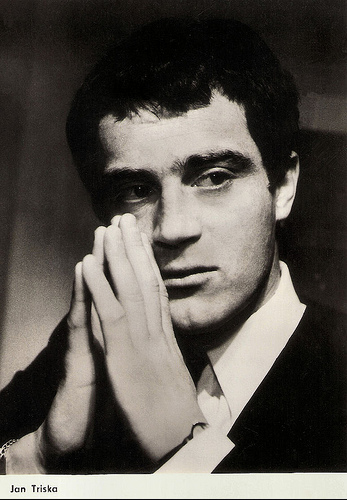
East-German postcard by VEB Progress Film-Vertrieb, no. 3147, 1968.
A half-wild creature from the African jungle
Jan Triska or Jan Tříska was born in Prague, Czechoslovakia (now Czech Republic), in 1936.
From 1957 on, he performed numerous roles in both the Czech theatre and cinema. He made his film debut in the lead role of the Czech comedy Váhavý strelec/The Hesitant Marksman (Ivo Toman, 1957) with Jaroslav Marvan. With Marvan, he also appeared in the romantic drama Pet z miliónu/Five Out of a Million (Zbynek Brynych, 1959).
In the following years, he mostly played small or supporting roles in Czech films, such as in Tarzanova smrt/The Death of Tarzan (Jaroslav Balík, 1963), a dark comedy about a half-wild creature from the African jungle, which has been identified as a heir of the noble family, set in Germany in the 1930s.
Other example are the comedy Komedie s Klikou/Comedy Around a Door Handle (Václav Krska, 1964), and the war drama Hvezda zvaná Pelynek/A Star Named Wormwood (Martin Fric, 1965), both starring Jirina Bohdalová. Triska also played a small part in the West-German film Das Haus in der Karpfengasse/The House in Karp Lane (Kurt Hoffmann, 1965), starring Jana Brejchová. The film won five German Film Awards.
Triska starred as an acrobat in the circus drama Lidé z maringotek/Life on Wheels (Martin Fric, 1966) and appeared in a leading role in the crime film Martin a cervené sklícko/A New Case for Master Detective Martin (Milan Vosmik, 1967), featuring Jaroslav Vízner. He also played a jewel robber in the crime film Hra bez pravidel/Jewel Robbers are Hunted (Jindrich Polák, 1967) , and a murder suspect in the thriller Ctyri v kruhu/Four in a Circle (Milos Makovec, 1968).
From then he also often worked for TV. In 1970, he co-starred in the fantasy Radúz a Mahulena/Radúz and Mahulena (Petr Weigl, 1970), with Magda Vásáryová, and in the comedy-fantasy Lucie a zazraky/Lucie and the Miracles (Ota Koval, 1970). He co-starred with Jana Brejchova in the screwball comedy Slecna Golem/Miss Golem (Jaroslav Balík, 1972), and had a supporting part in the East-German romantic drama Wie füttert man einen Esel/How to feed a Donkey (Roland Oehme, 1974) with Manfred Krug .
Tříska also played supporting parts in Jiri Menzel’s comedy-drama Na samote u lesa/Seclusion Near a Forest (1976), the award winning West-German film Der Mädchenkrieg/Maiden's War (Alf Brustellin, Bernhard Sinkel, 1977) and the East-German satire Ein irrer Duft von frischem Heu/A Terrific Scent of Fresh Hay (Roland Oehme, Karl-Heinz Lotz, 1977).
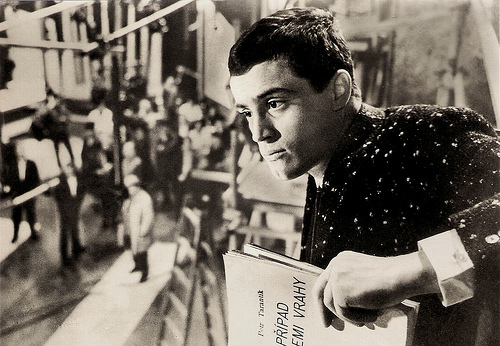
East-German postcard by VEB Progress Film-Vertrieb, Berlin, no. 2696, 1966. Publicity still for Pet miliónu svedku/Five Million Witnesses (Eva Sadková, 1965).
The assassin of Larry Flynt
Jan Tříska left Czechoslovakia in 1977 after signing a human rights manifesto inspired by his close friend, dissident playwright Václav Havel. He emigrated to the United States via Cyprus. He settled in Los Angeles and found work in his fellow Czech Miloš Forman's film Ragtime (1981), in which he played a small role as a special reporter.
That year, he also played Karl Radek in Warren Beatty’s Oscar winner Reds (1981). Other small parts followed in well-known films as the thriller The Osterman Weekend (Sam Peckinpah, 1983) starring Rutger Hauer , and 2010 (Peter Hyams, 1984), the sequel to Stanley Kubrick's 1968 science fiction epic 2001: A Space Odyssey.
His most notable Hollywood part was probably that of Milos, the loyal butler and personal assistant to Mr. Terry Silver (Thomas Ian Griffith), in The Karate Kid Part III (John G. Avildsen, 1989), starring Ralph Macchio. Tříska’s films were banned from Czechoslovakian cinemas and TV screens until the fall of communism in 1989.
After the anti-communist Velvet Revolution led by Havel, Tříska regularly returned home to appear in stage productions and films. He took a lead role in the comedy Obecná skola/The Elementary School (Jan Sverák, 1991), which was nominated for an Academy Award. He was again remarkable as the assassin of Larry Flynt (Woody Harrelson) in The People vs. Larry Flynt (Milos Forman, 1996).
Tříska also appeared on television, in popular series such as Quantum Leap (1990) and Highlander: The Series (1999), and in the TV film Andersonville (John Frankenheimer, 1996). On stage, he starred as the Devil in a New York Public Theater adaptation of The Master and Margarita. His later films include Hollywood productions such as Apt Pupil (Bryan Singer, 1998) with Ian McKellen, Ronin (John Frankenheimer, 1998), starring Robert De Niro , and Cahoots (Dirk Benedict, 2001).
From then on, he found his most interesting work in the Czech Republic, such as in the award winning drama Rok dábla/Year of the Devil (Petr Zelenka, 2002) with pop star Jaromir Nohavica, the romantic drama Zelary (Ondrej Trojan, 2003) and the comedy drama Horem pádem/Up and Down (Jan Hrebejk, 2004).
Tříska starred as a mysterious Marquis in Sílení/Lunacy (2005), Jan Svankmajer’s award winning animation film based on a story by Edgar Allan Poe and texts by Marquis De Sade. Craig Butler at AllMovie : “In the lead role, Pavel Liska is quite good; with his haunted, hangdog eyes, he conveys quite well the tortured, confused soul of his character. Even better is Jan Triska as the Marquis; his eyes sparkle with a devilish gleam that is both repellent and mesmerizing, and his braying cackle reveals as much about him as any of the dialogue he spouts."
Most recently, Triska appeared as a grandfather in Po strnisti bos/Barefoot (Jan Sverák, 2017) about a small boy, who is forced to move out of Prague during World War 2 to a small village of Slavonice where he meets the rest of his family. IMDb announces at the moment of writing still a new project in pre-production Na Strese (2018), to be directed by Jirí Mádl. Triska was due to begin work on the new Czech film last Monday. The project has now been postponed.
Prague theatre director Jan Hrušínský confirmed Tříska’s death on Monday. The actor died in Prague’s military hospital overnight due to injuries from the fall on Saturday, the circumstances of which remain unclear. Two passengers on a nearby boat rescued him from the Vltava river, after which he was resuscitated and hospitalised in serious condition. Prior to his identity being revealed, Prague firefighters tweeted that he had jumped from the bridge.
Jan Tříska had two daughters, Karla and Jana, with actress Karla Chadimová, and also had a grandson named Augustin.
Czech trailer for Obecná skola/The Elementary School (1991). Sorry, no subtitles. Source: Jan Svěrák (YouTube).
Trailer for Šílení/Lunacy (2005). Source: Zeitgeist Films (YouTube).
Sources: Craig Butler (AllMovie), Radio Praha, The Guardian, Wikipedia and .

East-German postcard by VEB Progress Film-Vertrieb, no. 3147, 1968.
A half-wild creature from the African jungle
Jan Triska or Jan Tříska was born in Prague, Czechoslovakia (now Czech Republic), in 1936.
From 1957 on, he performed numerous roles in both the Czech theatre and cinema. He made his film debut in the lead role of the Czech comedy Váhavý strelec/The Hesitant Marksman (Ivo Toman, 1957) with Jaroslav Marvan. With Marvan, he also appeared in the romantic drama Pet z miliónu/Five Out of a Million (Zbynek Brynych, 1959).
In the following years, he mostly played small or supporting roles in Czech films, such as in Tarzanova smrt/The Death of Tarzan (Jaroslav Balík, 1963), a dark comedy about a half-wild creature from the African jungle, which has been identified as a heir of the noble family, set in Germany in the 1930s.
Other example are the comedy Komedie s Klikou/Comedy Around a Door Handle (Václav Krska, 1964), and the war drama Hvezda zvaná Pelynek/A Star Named Wormwood (Martin Fric, 1965), both starring Jirina Bohdalová. Triska also played a small part in the West-German film Das Haus in der Karpfengasse/The House in Karp Lane (Kurt Hoffmann, 1965), starring Jana Brejchová. The film won five German Film Awards.
Triska starred as an acrobat in the circus drama Lidé z maringotek/Life on Wheels (Martin Fric, 1966) and appeared in a leading role in the crime film Martin a cervené sklícko/A New Case for Master Detective Martin (Milan Vosmik, 1967), featuring Jaroslav Vízner. He also played a jewel robber in the crime film Hra bez pravidel/Jewel Robbers are Hunted (Jindrich Polák, 1967) , and a murder suspect in the thriller Ctyri v kruhu/Four in a Circle (Milos Makovec, 1968).
From then he also often worked for TV. In 1970, he co-starred in the fantasy Radúz a Mahulena/Radúz and Mahulena (Petr Weigl, 1970), with Magda Vásáryová, and in the comedy-fantasy Lucie a zazraky/Lucie and the Miracles (Ota Koval, 1970). He co-starred with Jana Brejchova in the screwball comedy Slecna Golem/Miss Golem (Jaroslav Balík, 1972), and had a supporting part in the East-German romantic drama Wie füttert man einen Esel/How to feed a Donkey (Roland Oehme, 1974) with Manfred Krug .
Tříska also played supporting parts in Jiri Menzel’s comedy-drama Na samote u lesa/Seclusion Near a Forest (1976), the award winning West-German film Der Mädchenkrieg/Maiden's War (Alf Brustellin, Bernhard Sinkel, 1977) and the East-German satire Ein irrer Duft von frischem Heu/A Terrific Scent of Fresh Hay (Roland Oehme, Karl-Heinz Lotz, 1977).

East-German postcard by VEB Progress Film-Vertrieb, Berlin, no. 2696, 1966. Publicity still for Pet miliónu svedku/Five Million Witnesses (Eva Sadková, 1965).
The assassin of Larry Flynt
Jan Tříska left Czechoslovakia in 1977 after signing a human rights manifesto inspired by his close friend, dissident playwright Václav Havel. He emigrated to the United States via Cyprus. He settled in Los Angeles and found work in his fellow Czech Miloš Forman's film Ragtime (1981), in which he played a small role as a special reporter.
That year, he also played Karl Radek in Warren Beatty’s Oscar winner Reds (1981). Other small parts followed in well-known films as the thriller The Osterman Weekend (Sam Peckinpah, 1983) starring Rutger Hauer , and 2010 (Peter Hyams, 1984), the sequel to Stanley Kubrick's 1968 science fiction epic 2001: A Space Odyssey.
His most notable Hollywood part was probably that of Milos, the loyal butler and personal assistant to Mr. Terry Silver (Thomas Ian Griffith), in The Karate Kid Part III (John G. Avildsen, 1989), starring Ralph Macchio. Tříska’s films were banned from Czechoslovakian cinemas and TV screens until the fall of communism in 1989.
After the anti-communist Velvet Revolution led by Havel, Tříska regularly returned home to appear in stage productions and films. He took a lead role in the comedy Obecná skola/The Elementary School (Jan Sverák, 1991), which was nominated for an Academy Award. He was again remarkable as the assassin of Larry Flynt (Woody Harrelson) in The People vs. Larry Flynt (Milos Forman, 1996).
Tříska also appeared on television, in popular series such as Quantum Leap (1990) and Highlander: The Series (1999), and in the TV film Andersonville (John Frankenheimer, 1996). On stage, he starred as the Devil in a New York Public Theater adaptation of The Master and Margarita. His later films include Hollywood productions such as Apt Pupil (Bryan Singer, 1998) with Ian McKellen, Ronin (John Frankenheimer, 1998), starring Robert De Niro , and Cahoots (Dirk Benedict, 2001).
From then on, he found his most interesting work in the Czech Republic, such as in the award winning drama Rok dábla/Year of the Devil (Petr Zelenka, 2002) with pop star Jaromir Nohavica, the romantic drama Zelary (Ondrej Trojan, 2003) and the comedy drama Horem pádem/Up and Down (Jan Hrebejk, 2004).
Tříska starred as a mysterious Marquis in Sílení/Lunacy (2005), Jan Svankmajer’s award winning animation film based on a story by Edgar Allan Poe and texts by Marquis De Sade. Craig Butler at AllMovie : “In the lead role, Pavel Liska is quite good; with his haunted, hangdog eyes, he conveys quite well the tortured, confused soul of his character. Even better is Jan Triska as the Marquis; his eyes sparkle with a devilish gleam that is both repellent and mesmerizing, and his braying cackle reveals as much about him as any of the dialogue he spouts."
Most recently, Triska appeared as a grandfather in Po strnisti bos/Barefoot (Jan Sverák, 2017) about a small boy, who is forced to move out of Prague during World War 2 to a small village of Slavonice where he meets the rest of his family. IMDb announces at the moment of writing still a new project in pre-production Na Strese (2018), to be directed by Jirí Mádl. Triska was due to begin work on the new Czech film last Monday. The project has now been postponed.
Prague theatre director Jan Hrušínský confirmed Tříska’s death on Monday. The actor died in Prague’s military hospital overnight due to injuries from the fall on Saturday, the circumstances of which remain unclear. Two passengers on a nearby boat rescued him from the Vltava river, after which he was resuscitated and hospitalised in serious condition. Prior to his identity being revealed, Prague firefighters tweeted that he had jumped from the bridge.
Jan Tříska had two daughters, Karla and Jana, with actress Karla Chadimová, and also had a grandson named Augustin.
Czech trailer for Obecná skola/The Elementary School (1991). Sorry, no subtitles. Source: Jan Svěrák (YouTube).
Trailer for Šílení/Lunacy (2005). Source: Zeitgeist Films (YouTube).
Sources: Craig Butler (AllMovie), Radio Praha, The Guardian, Wikipedia and .
Published on September 27, 2017 13:44
September 26, 2017
Adele Sandrock
During the Netherlands Film Festival, EFSP presents the Unofficial Dutch Film Star Postcards Festival. Today's subject is Grand German-Dutch actress Adele Sandrock (1863-1937), who had a successful theatrical career all over Europe. In Vienna she had a stormy affair with the famous author Arthur Schnitzler, and enjoyed triumphs as the diva of the modern playwrights. In the 1910s she became one of the first German film stars. After the introduction of sound film, she emerged as a witty comedienne. She excelled as the intimidating elderly dragon, who could also be surprisingly funny and tactful.

German Postcard by Ross Verlag, no. 7363/1, 1933-1934. Photo: FFG.
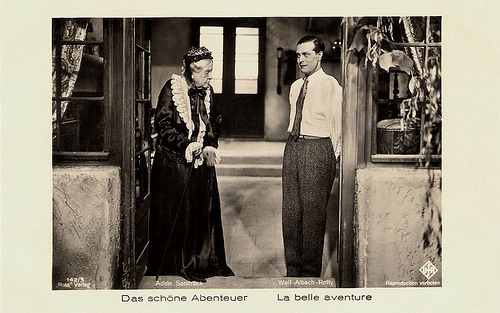
German postcard by Ross Verlag, no. 142/3. Photo: Ufa. Publicity still for Das schöne Abenteuer/Beautiful Adventure (Reinhold Schünzel, 1932) with Wolf Albach-Retty .
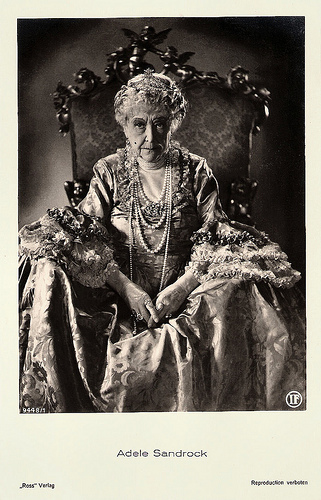
German Postcard by Ross Verlag, no. 9448, 1935-1936. Photo: IF. Publicity still for Der Favorit der Kaiserin/The Favorite of the Empress (Werner Hochbaum, 1936).
Tumultuous Private Life
Adele Sandrock was born as Adele Feldern-Förster in Rotterdam in the Netherlands in 1863 (some sources say 1864). She was the youngest of three children of the German businessman Eduard Othello Sandrock and the Dutch ballet dancer and actress Nan ten Hagen. Her siblings were painter and author Christian Sandrock and actress Wilhelmine Sandrock.
In 1875 the family moved to Berlin. Three years later, Adele was discharged from school, and she tried to become an actress. Only 15, she made her debut in the comedy Mutter und Sohn (Mother and Son) by Charlotte Birch-Pfeiffer at the Urania theatre in a Berlin suburb.
Later, she asked the Duke of Meiningen in a letter to engage her at the Hoftheater (Court Theatre). She chose a scene from Kabale und Liebe (Intrigue and Love) by Friedrich Schiller to show off her talent. The Duchess, a former actress, was so delighted by her acting that Sandrock received a three-year contract.
When the famous actor Joseph Kainz refused to play her lover, she was deeply hurt and left Meiningen after only one year. She played in theatres in Moscow and Budapest, and also worked in Spain and France. In 1889 she moved to Vienna, where she had her breakthrough in the title role of Isabella in The Clemenceau Case by Alexandre Dumas and Armand d'Artois at the Theater an der Wien.
From 1889 to 1895 she played at the Deutschen Volkstheater (German National Theatre) in Vienna. In 1893 she met the poet Arthur Schnitzler and the two had a tempestuous love affair that lasted for two years. In his works Der Reigen (The Dance), Halbzwei (Two and Half) and Haus Delorme (House Delorme), Schnitzler used his memories of Adele Sandrock. Their intimate correspondence was published in book form.
In Vienna, Sandrock became a star and her tumultuous private life and her breach of contracts created some scandals. She became the diva of the 'Wiener Moderne’, the Austrian avant-garde movement. She created a number of major roles for such modern playwrights as Henrik Ibsen (in Rosmersholm) and Arthur Schnitzler (in Das Märchen (Fairy Tale) and Liebelei (Flirtation)).
From 1895 to 1898, she worked with her older sister Wilhelmine at the Hofburgtheater (Court Theatre) and later she went on a European tour. From 1902 to 1905 she worked again at the Deutschen Volkstheater in Vienna, but she could not repeat her previous triumphs. In 1905 she moved to Berlin, where she played at the Deutsches Theater under Max Reinhardt. In 1910 her engagement there ended and there were no new parts or engagements. Her highly theatrical style was regarded as old-fashioned now. It was a period of financial hardships.
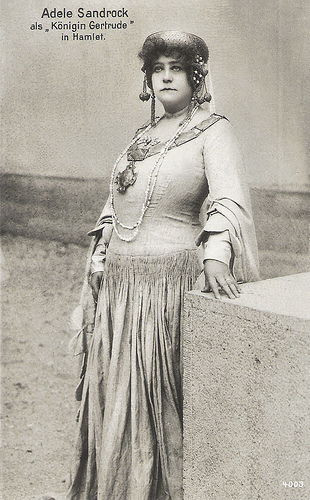
German Postcard by Verl. Hermann Leiser, Berlin, no. 4003. Photo: Photo-Arbeit, München (Munich). Publicity still for a stage production of Hamlet with Adele Sandrock as Queen Gertrude.
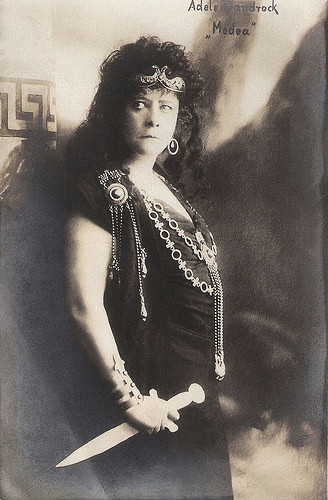
Vintage Postcard. Publicity still for a stage production of Medea.
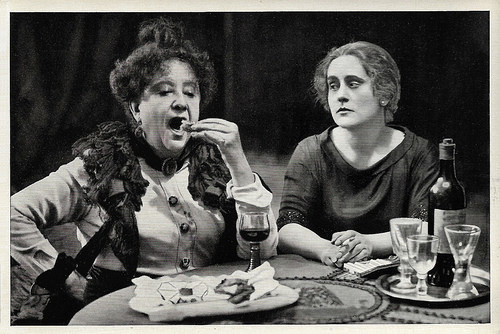
German collectors card by Ross Verlag in the series Vom Werden deutscher Filmkunst - Der Stumme Film, picture no. 197. Photo: Maxim-Film. Publicity still with Adele Sandrock and Carola Toelle in Die Schuld des Grafen Weronski/The debt of Count Weronski (Rudolf Biebrach, 1921).
Funny Old Lady
In 1911 Adele Sandrock made her silent film debut for the Messter company in the short film Marianne, ein Weib aus dem Volk/Marianne, a woman from the people, starring Henny Porten . It was followed by parts in such films as Die Beichte einer Verurteilten/The confession of a condemned (Rudolf del Zopp, 1915) and Passionels Tagebuch/Passionels diary (Louis Ralph, 1916) with Emil Jannings .
During World War I, Adele earned a small family income by giving lectures and acting lessons. After the war she worked more and more for the cinema. To her silent films belong Manolescus Memoiren/The Memories of Manolescu (Richard Oswald, 1920) starring Conrad Veidt , Lady Hamilton (Richard Oswald, 1921), and Kinder der Finsternis/Children of the Dark (Ewald André Dupont, 1921).
In 1924 she returned to the Netherlands to film Op hoop van zegen/Die Fahrt ins Verderben (James Bauer, Henk Kleinmann, 1924), a Dutch-German coproduction, based on the play Op hoop van zegen (1900) by Herman Heijermans. Other silent films were Die Waise von Lowood/Orphan of Lowood (Curtis Bernhardt, 1926), Feme (Richard Oswald, 1927), the Schnitzler adaptation Fräulein Else/Miss Else (Paul Czinner, 1929) and Katharina Knie (Karl Grune, 1929) with Carmen Boni .
In 1920 the then 50-plus-Sandrock had also returned to the stage, where she again enjoyed great successes, this time as a funny old lady in such comedies as Liebestrank (Love Poison) by Frank Wedekind and Bunbury by Oscar Wilde. It was her second breakthrough, now as a comedienne. Sandrock developed a unique form of ‘unmodern’ comedy. She was hilarious as the stubborn, old fashioned mother-in-law, or the tyrannical grandmother.
She still also took serious roles in silent films, but when the German sound film was introduced in 1930, she could use her comic talent fully in the cinema. She appeared in box-office hits as Der Kongress tanzt/The Congress Dances (Eric Charell, 1931) starring Lilian Harvey , Der tolle Bomberg/The Mad Bomberg (Georg Asagaroff, 1932), and Die englische Heirat/The English Wedding (Reinhold Schünzel, 1934).
She was a comedian who spoke out for passion. Sandrock even became better known for her film roles than for her stage career, and in 1935 and 1936 she took part in 16 films. Even today people remember her as Juno in Amphitryon (Reinhold Schünzel, 1935). Another classic was her role as a director in Alles hört auf mein Kommando/Everything hears on my command (Georg Zoch, 1935), a title that describes her principal quality. Because of her distinctive deep tinny voice she was called ‘der General’ (the General).
During her career Adele Sandrock acted in more than 140 films. Sandrock remained unmarried all her life. She lived with her sister, Wilhelmine in an apartment in Berlin, where she died in 1937. The cause of her death was the aftermath of an accident in 1936. Her autobiography, Mein Leben (My Life), was published in 1940.
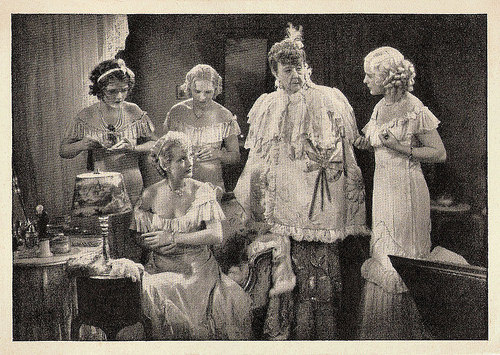
Promotion card by Ufa. Photo: publicity still for Der Letzte Walzer/The Last Waltz (Georg Jacoby, 1934).
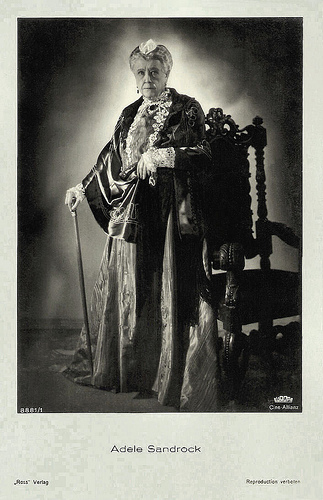
German Postcard by Ross Verlag, no. 8881, 1934-1935. Photo: Cine Allianz / Europa. Publicity still for Die englische Heirat/The English marriage (Reinhold Schünzel, 1934).
German coffee commercial Die kluge tante Adele/The Smart Aunt Adele. Source: CoffeeInternational (YouTube).
Scene from Rendezvous in Wien/Rendezvous in Vienna (Victor Janson, 1936) with Leo Slezak. Source: BD130 (YouTube).
Sources: Thomas Staedeli (Cyranos), Stephanie D’heil (Steffi-line) (German), Wikipedia (English and German) and .

German Postcard by Ross Verlag, no. 7363/1, 1933-1934. Photo: FFG.

German postcard by Ross Verlag, no. 142/3. Photo: Ufa. Publicity still for Das schöne Abenteuer/Beautiful Adventure (Reinhold Schünzel, 1932) with Wolf Albach-Retty .

German Postcard by Ross Verlag, no. 9448, 1935-1936. Photo: IF. Publicity still for Der Favorit der Kaiserin/The Favorite of the Empress (Werner Hochbaum, 1936).
Tumultuous Private Life
Adele Sandrock was born as Adele Feldern-Förster in Rotterdam in the Netherlands in 1863 (some sources say 1864). She was the youngest of three children of the German businessman Eduard Othello Sandrock and the Dutch ballet dancer and actress Nan ten Hagen. Her siblings were painter and author Christian Sandrock and actress Wilhelmine Sandrock.
In 1875 the family moved to Berlin. Three years later, Adele was discharged from school, and she tried to become an actress. Only 15, she made her debut in the comedy Mutter und Sohn (Mother and Son) by Charlotte Birch-Pfeiffer at the Urania theatre in a Berlin suburb.
Later, she asked the Duke of Meiningen in a letter to engage her at the Hoftheater (Court Theatre). She chose a scene from Kabale und Liebe (Intrigue and Love) by Friedrich Schiller to show off her talent. The Duchess, a former actress, was so delighted by her acting that Sandrock received a three-year contract.
When the famous actor Joseph Kainz refused to play her lover, she was deeply hurt and left Meiningen after only one year. She played in theatres in Moscow and Budapest, and also worked in Spain and France. In 1889 she moved to Vienna, where she had her breakthrough in the title role of Isabella in The Clemenceau Case by Alexandre Dumas and Armand d'Artois at the Theater an der Wien.
From 1889 to 1895 she played at the Deutschen Volkstheater (German National Theatre) in Vienna. In 1893 she met the poet Arthur Schnitzler and the two had a tempestuous love affair that lasted for two years. In his works Der Reigen (The Dance), Halbzwei (Two and Half) and Haus Delorme (House Delorme), Schnitzler used his memories of Adele Sandrock. Their intimate correspondence was published in book form.
In Vienna, Sandrock became a star and her tumultuous private life and her breach of contracts created some scandals. She became the diva of the 'Wiener Moderne’, the Austrian avant-garde movement. She created a number of major roles for such modern playwrights as Henrik Ibsen (in Rosmersholm) and Arthur Schnitzler (in Das Märchen (Fairy Tale) and Liebelei (Flirtation)).
From 1895 to 1898, she worked with her older sister Wilhelmine at the Hofburgtheater (Court Theatre) and later she went on a European tour. From 1902 to 1905 she worked again at the Deutschen Volkstheater in Vienna, but she could not repeat her previous triumphs. In 1905 she moved to Berlin, where she played at the Deutsches Theater under Max Reinhardt. In 1910 her engagement there ended and there were no new parts or engagements. Her highly theatrical style was regarded as old-fashioned now. It was a period of financial hardships.

German Postcard by Verl. Hermann Leiser, Berlin, no. 4003. Photo: Photo-Arbeit, München (Munich). Publicity still for a stage production of Hamlet with Adele Sandrock as Queen Gertrude.

Vintage Postcard. Publicity still for a stage production of Medea.

German collectors card by Ross Verlag in the series Vom Werden deutscher Filmkunst - Der Stumme Film, picture no. 197. Photo: Maxim-Film. Publicity still with Adele Sandrock and Carola Toelle in Die Schuld des Grafen Weronski/The debt of Count Weronski (Rudolf Biebrach, 1921).
Funny Old Lady
In 1911 Adele Sandrock made her silent film debut for the Messter company in the short film Marianne, ein Weib aus dem Volk/Marianne, a woman from the people, starring Henny Porten . It was followed by parts in such films as Die Beichte einer Verurteilten/The confession of a condemned (Rudolf del Zopp, 1915) and Passionels Tagebuch/Passionels diary (Louis Ralph, 1916) with Emil Jannings .
During World War I, Adele earned a small family income by giving lectures and acting lessons. After the war she worked more and more for the cinema. To her silent films belong Manolescus Memoiren/The Memories of Manolescu (Richard Oswald, 1920) starring Conrad Veidt , Lady Hamilton (Richard Oswald, 1921), and Kinder der Finsternis/Children of the Dark (Ewald André Dupont, 1921).
In 1924 she returned to the Netherlands to film Op hoop van zegen/Die Fahrt ins Verderben (James Bauer, Henk Kleinmann, 1924), a Dutch-German coproduction, based on the play Op hoop van zegen (1900) by Herman Heijermans. Other silent films were Die Waise von Lowood/Orphan of Lowood (Curtis Bernhardt, 1926), Feme (Richard Oswald, 1927), the Schnitzler adaptation Fräulein Else/Miss Else (Paul Czinner, 1929) and Katharina Knie (Karl Grune, 1929) with Carmen Boni .
In 1920 the then 50-plus-Sandrock had also returned to the stage, where she again enjoyed great successes, this time as a funny old lady in such comedies as Liebestrank (Love Poison) by Frank Wedekind and Bunbury by Oscar Wilde. It was her second breakthrough, now as a comedienne. Sandrock developed a unique form of ‘unmodern’ comedy. She was hilarious as the stubborn, old fashioned mother-in-law, or the tyrannical grandmother.
She still also took serious roles in silent films, but when the German sound film was introduced in 1930, she could use her comic talent fully in the cinema. She appeared in box-office hits as Der Kongress tanzt/The Congress Dances (Eric Charell, 1931) starring Lilian Harvey , Der tolle Bomberg/The Mad Bomberg (Georg Asagaroff, 1932), and Die englische Heirat/The English Wedding (Reinhold Schünzel, 1934).
She was a comedian who spoke out for passion. Sandrock even became better known for her film roles than for her stage career, and in 1935 and 1936 she took part in 16 films. Even today people remember her as Juno in Amphitryon (Reinhold Schünzel, 1935). Another classic was her role as a director in Alles hört auf mein Kommando/Everything hears on my command (Georg Zoch, 1935), a title that describes her principal quality. Because of her distinctive deep tinny voice she was called ‘der General’ (the General).
During her career Adele Sandrock acted in more than 140 films. Sandrock remained unmarried all her life. She lived with her sister, Wilhelmine in an apartment in Berlin, where she died in 1937. The cause of her death was the aftermath of an accident in 1936. Her autobiography, Mein Leben (My Life), was published in 1940.

Promotion card by Ufa. Photo: publicity still for Der Letzte Walzer/The Last Waltz (Georg Jacoby, 1934).

German Postcard by Ross Verlag, no. 8881, 1934-1935. Photo: Cine Allianz / Europa. Publicity still for Die englische Heirat/The English marriage (Reinhold Schünzel, 1934).
German coffee commercial Die kluge tante Adele/The Smart Aunt Adele. Source: CoffeeInternational (YouTube).
Scene from Rendezvous in Wien/Rendezvous in Vienna (Victor Janson, 1936) with Leo Slezak. Source: BD130 (YouTube).
Sources: Thomas Staedeli (Cyranos), Stephanie D’heil (Steffi-line) (German), Wikipedia (English and German) and .
Published on September 26, 2017 22:00
Kveta Fialová (1929-2017)
Yesterday, 26 September 2017, Czech actress Květa Fialová (1929) has passed away. In her country, she was a popular theatre, film and television diva. Internationally she is best known for her role as bar singer Tornado Lou in the Western parody Limonádový Joe aneb Konská opera/Lemonade Joe (1964).
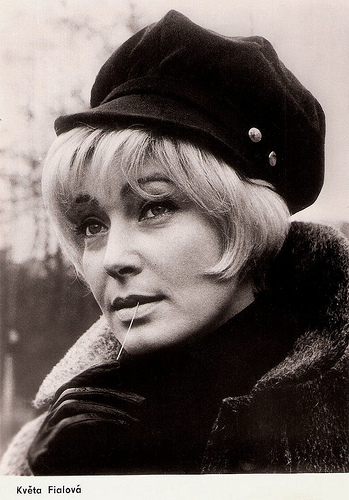
East-German postcard by VEB Progress Film-Vertrieb, no. 3170, 1968. Retail price: 0,20 DM. Photo: Progress.
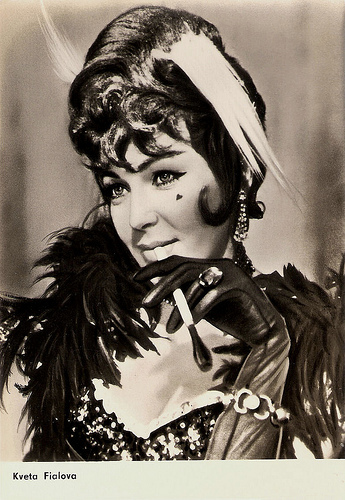
East-German postcard by VEB Progress Film-Vertrieb, no. 2.125, 1964. Photo: Limonádový Joe aneb Konská opera/Lemonade Joe (Oldrich Lipský, 1964).
Traumatic Experience
Květa Fialová was born in Veľkých Dravcích (Vel’ké Dravce), Czechoslovakia (now Slovak Republic) in 1929. Her mother was the artist and sculptor Květoslava Fialová and her father the Czech legionary Vlastimil Fiala.
The family lived in Slovakia until 1938, when the nationalists were driven to the Czech Republic. They moved to Zdar and later to Borohrádku. At the end of the war her mother and Kveta were raped by Soviet soldiers, which was the most traumatic experience of her life.
From 1946 till 1950, she studied at the Janáček Academy in Brno. In 1950 she made her film debut with a small part in the drama Veliká prílezitost/The Great Opportunity (K.M. Wallo, 1950). The next years followed supporting roles in Czech films as Stika v rybníce/The Pike in a Fish Pond (Vladimír Cech, 1951), Plavecký mariás/Rivers 1x1 (Václav Wasserman, 1953) and Strakonický dudák/The Strakonice Bagpiper (Karel Stekly, 1955).
Meanwhile Fialová worked at several regional theatres, in the Czech cities of Těšíně (Cieszyn), Opavě (Opava) and Budějovicích (Budejovice), in Germany in Köln (Cologne), and in Slovakia in Martině (Martin). Since 1958 she was engaged at Prague's Divadlo ABC (ABC Theater), which at that time was directed by Jan Werich.
In Prague she had a larger choice of film roles and she appeared in such films as Tenkrát o vánocích/At That Time, at Christmas... (Karel Kachyna, 1958) and Dum na Orechovce/A Suburban Villa (Vladislav Delong, 1959) with Jiri Vala. After the ABC Theatre had merged with the Městskými divadly (Municipal Theatre of Prague) in 1963, she worked there until 1990. In subsequent years, she was a permanent guest actor at the theatre.
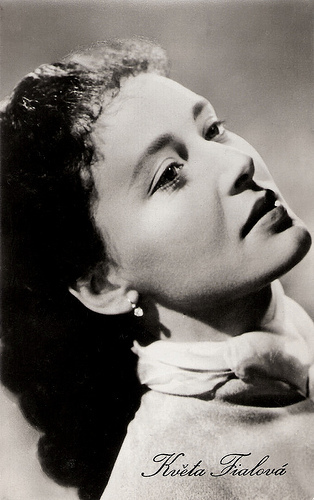
East-German postcard by VEB Progress Film-Vertrieb, Berlin, no. 727, 1958. Photo: publicity still for Zlaty pavouk/The Golden Spider (Pavel Blumenfeld, 1957).
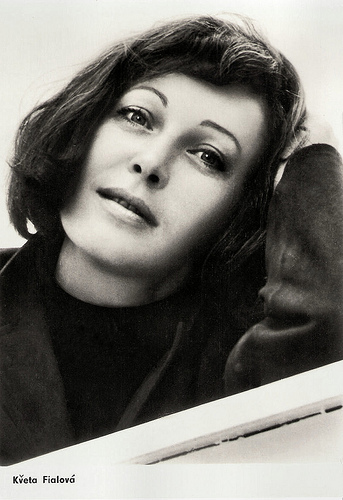
East-German postcard by VEB Progress Film-Vertrieb, no. 2.645, 1966. Photo: Balinski.
Prague Springtime
During her long career, Květa Fialová played many characters in dozens of films. Some of her finest films were made during the Prague Springtime of the early 1960s.
Probably her best known role is that of bar singer Tornado Lou in the wild and funny Western parody Limonádový Joe aneb Konská opera/Lemonade Joe (Oldrich Lipský, 1964) starring Karel Fiala.
Hal Erickson at AllMovie : “Lemonade Joe is a sweet-natured Czechoslovakian spoof of Hollywood westerns. Hero Lemonade Joe (Carl Fiala) is so named because he refuses to drink the ‘hard stuff’ when he saunters into the local saloon. The plot exaggerates all the supposedly standard cowboy clichés, including dance hall girls with golden hearts, masked rustlers, and the sundown showdown. Halfway through, director Oldrich Lipsky (a graduate of Prague's Satirical Theatre) has nowhere further to go and begins repeating himself - then finds that he has to take certain plot threads seriously in order to expedite a happy ending. Nonetheless, the overall cheerfulness and virtuosity of the project won Lemonade Joe plenty of critical praise”.
Reportedly, the film made Fialová a kind of sex symbol in Eastern Europe. In a satire on the pulp novel, Fantom Morrisvillu/The Phantom of Morrisville (Borivoj Zeman, 1966), she played Hannibal’s fiancee. That year she also played a small part in another internationally successful comedy, Ostre sledované vlaky/Closely Watched Trains (Jirí Menzel, 1966). The film, based on Bohumil Hrabal's novel of the same name, was the recipient of the Academy Award for Best Foreign Language Film in 1967. Vaclav Neckar plays a Czech railroad worker during the Nazi occupation, who becomes attracted to the Czech underground.
Another successful satire was Konec agenta W4C prostrednictvím psa pana Foustky/The End of Agent W4C (Václav Vorlícek, 1967), which was a spoof on the James Bond films. Interesting was also the black comedy Vrazda po cesku/Murder Czech Style (Jirí Weiss, 1968).
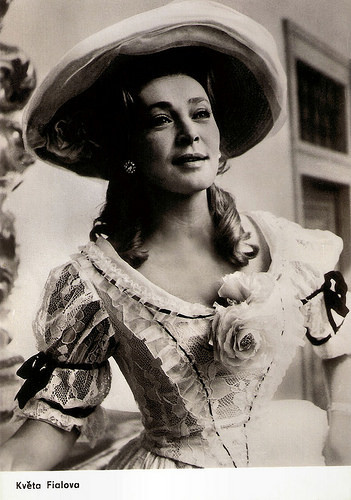
East-German postcard by VEB Progress Film-Vertrieb, no. 16/69. Photo: publicity still for Jarní vody/Spring Waters (Václav Krska, 1968).
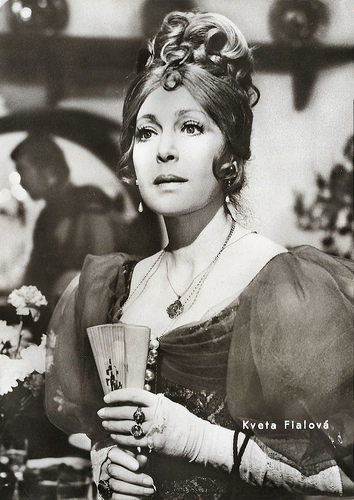
East-German postcard by VEB Progress Film-Vertrieb, Berlin, no. 101/75. Photo: publicity still for Do zbrane kuruci!/To the guns, rebels! (Andrej Lettrich, 1974).
Nick Carter
After the Soviets had violently broken the Prague Springtime, Květa Fialová continued to make films but the results were less interesting than before.
Her better films of the 1970s include the crime film Partie krásného dragouna/The Matches of a Beautiful Dragoon (Jirí Sequens, 1970), the comedy Slamený klobouk/Straw Hat (Oldrich Lipský, 1972), and another genre spoof, Adéla jeste nevecerela/Nick Carter in Prague (Oldrich Lipský, 1978) with Michal Docolomanský as the legendary American detective Nick Carter.
Fialová also appeared in many television films and series, and also often dubbed foreign programs. During the 1980s and 1990s she continued to combine her TV and stage work with appearances in films.
These films include the family comedy S tebou me baví svet/Snowmen with Hearts (Marie Polednáková, 1983), the French-Czech fantasy Une trop bruyante solitude/Too Loud a Solitude (Verá Caïs, 1996) starring Philippe Noiret, and the comedy Bájecná léta pod psa/Wonderful Years That Sucked (Petr Nikolaev, 1997).
In the new century she kept busy playing grandmothers in TV series and films, including the mild comedy Úcastníci zájezdu/Holiday Makers (Jirí Vejdelek, 2006). One of her last stage triumphs was her leading role in the play Harold and Maude.
Květa Fialová was married twice. After an early marriage at 21, she was married to director Pavla Háši from 1957 until his death in 2009. They had a daughter Zuzana (1962). Fialová was now the grandmother of Dominiky.
Trailer for Limonádový Joe aneb Koňská opera/Lemonade Joe (1964). Source: filmexporthomevideo (YouTube).
Trailer of Adéla ještě nevečeřela/Nick Carter in Prague (1978). Source: kl1138 (YouTube).
Sources: Hal Erickson (AllMovie), Milan ‘Gudaulin’ Černý (ČSFD.cz - czech), Wikipedia (Czech), and .

East-German postcard by VEB Progress Film-Vertrieb, no. 3170, 1968. Retail price: 0,20 DM. Photo: Progress.

East-German postcard by VEB Progress Film-Vertrieb, no. 2.125, 1964. Photo: Limonádový Joe aneb Konská opera/Lemonade Joe (Oldrich Lipský, 1964).
Traumatic Experience
Květa Fialová was born in Veľkých Dravcích (Vel’ké Dravce), Czechoslovakia (now Slovak Republic) in 1929. Her mother was the artist and sculptor Květoslava Fialová and her father the Czech legionary Vlastimil Fiala.
The family lived in Slovakia until 1938, when the nationalists were driven to the Czech Republic. They moved to Zdar and later to Borohrádku. At the end of the war her mother and Kveta were raped by Soviet soldiers, which was the most traumatic experience of her life.
From 1946 till 1950, she studied at the Janáček Academy in Brno. In 1950 she made her film debut with a small part in the drama Veliká prílezitost/The Great Opportunity (K.M. Wallo, 1950). The next years followed supporting roles in Czech films as Stika v rybníce/The Pike in a Fish Pond (Vladimír Cech, 1951), Plavecký mariás/Rivers 1x1 (Václav Wasserman, 1953) and Strakonický dudák/The Strakonice Bagpiper (Karel Stekly, 1955).
Meanwhile Fialová worked at several regional theatres, in the Czech cities of Těšíně (Cieszyn), Opavě (Opava) and Budějovicích (Budejovice), in Germany in Köln (Cologne), and in Slovakia in Martině (Martin). Since 1958 she was engaged at Prague's Divadlo ABC (ABC Theater), which at that time was directed by Jan Werich.
In Prague she had a larger choice of film roles and she appeared in such films as Tenkrát o vánocích/At That Time, at Christmas... (Karel Kachyna, 1958) and Dum na Orechovce/A Suburban Villa (Vladislav Delong, 1959) with Jiri Vala. After the ABC Theatre had merged with the Městskými divadly (Municipal Theatre of Prague) in 1963, she worked there until 1990. In subsequent years, she was a permanent guest actor at the theatre.

East-German postcard by VEB Progress Film-Vertrieb, Berlin, no. 727, 1958. Photo: publicity still for Zlaty pavouk/The Golden Spider (Pavel Blumenfeld, 1957).

East-German postcard by VEB Progress Film-Vertrieb, no. 2.645, 1966. Photo: Balinski.
Prague Springtime
During her long career, Květa Fialová played many characters in dozens of films. Some of her finest films were made during the Prague Springtime of the early 1960s.
Probably her best known role is that of bar singer Tornado Lou in the wild and funny Western parody Limonádový Joe aneb Konská opera/Lemonade Joe (Oldrich Lipský, 1964) starring Karel Fiala.
Hal Erickson at AllMovie : “Lemonade Joe is a sweet-natured Czechoslovakian spoof of Hollywood westerns. Hero Lemonade Joe (Carl Fiala) is so named because he refuses to drink the ‘hard stuff’ when he saunters into the local saloon. The plot exaggerates all the supposedly standard cowboy clichés, including dance hall girls with golden hearts, masked rustlers, and the sundown showdown. Halfway through, director Oldrich Lipsky (a graduate of Prague's Satirical Theatre) has nowhere further to go and begins repeating himself - then finds that he has to take certain plot threads seriously in order to expedite a happy ending. Nonetheless, the overall cheerfulness and virtuosity of the project won Lemonade Joe plenty of critical praise”.
Reportedly, the film made Fialová a kind of sex symbol in Eastern Europe. In a satire on the pulp novel, Fantom Morrisvillu/The Phantom of Morrisville (Borivoj Zeman, 1966), she played Hannibal’s fiancee. That year she also played a small part in another internationally successful comedy, Ostre sledované vlaky/Closely Watched Trains (Jirí Menzel, 1966). The film, based on Bohumil Hrabal's novel of the same name, was the recipient of the Academy Award for Best Foreign Language Film in 1967. Vaclav Neckar plays a Czech railroad worker during the Nazi occupation, who becomes attracted to the Czech underground.
Another successful satire was Konec agenta W4C prostrednictvím psa pana Foustky/The End of Agent W4C (Václav Vorlícek, 1967), which was a spoof on the James Bond films. Interesting was also the black comedy Vrazda po cesku/Murder Czech Style (Jirí Weiss, 1968).

East-German postcard by VEB Progress Film-Vertrieb, no. 16/69. Photo: publicity still for Jarní vody/Spring Waters (Václav Krska, 1968).

East-German postcard by VEB Progress Film-Vertrieb, Berlin, no. 101/75. Photo: publicity still for Do zbrane kuruci!/To the guns, rebels! (Andrej Lettrich, 1974).
Nick Carter
After the Soviets had violently broken the Prague Springtime, Květa Fialová continued to make films but the results were less interesting than before.
Her better films of the 1970s include the crime film Partie krásného dragouna/The Matches of a Beautiful Dragoon (Jirí Sequens, 1970), the comedy Slamený klobouk/Straw Hat (Oldrich Lipský, 1972), and another genre spoof, Adéla jeste nevecerela/Nick Carter in Prague (Oldrich Lipský, 1978) with Michal Docolomanský as the legendary American detective Nick Carter.
Fialová also appeared in many television films and series, and also often dubbed foreign programs. During the 1980s and 1990s she continued to combine her TV and stage work with appearances in films.
These films include the family comedy S tebou me baví svet/Snowmen with Hearts (Marie Polednáková, 1983), the French-Czech fantasy Une trop bruyante solitude/Too Loud a Solitude (Verá Caïs, 1996) starring Philippe Noiret, and the comedy Bájecná léta pod psa/Wonderful Years That Sucked (Petr Nikolaev, 1997).
In the new century she kept busy playing grandmothers in TV series and films, including the mild comedy Úcastníci zájezdu/Holiday Makers (Jirí Vejdelek, 2006). One of her last stage triumphs was her leading role in the play Harold and Maude.
Květa Fialová was married twice. After an early marriage at 21, she was married to director Pavla Háši from 1957 until his death in 2009. They had a daughter Zuzana (1962). Fialová was now the grandmother of Dominiky.
Trailer for Limonádový Joe aneb Koňská opera/Lemonade Joe (1964). Source: filmexporthomevideo (YouTube).
Trailer of Adéla ještě nevečeřela/Nick Carter in Prague (1978). Source: kl1138 (YouTube).
Sources: Hal Erickson (AllMovie), Milan ‘Gudaulin’ Černý (ČSFD.cz - czech), Wikipedia (Czech), and .
Published on September 26, 2017 15:55
September 25, 2017
Jan Smit
Every year during the last week of September, Utrecht is the Dutch capital of film. This is the time of the Netherlands Film Festival (NFF), and traditionally EFSP organises its own Unofficial Netherlands Film Star Postcard Festival. Today we present Dutch singer, television host and incidental actor Jan Smit (1985). His songs fall under the Dutch genre known as 'Palingsound' (Volendam music). As a child, 'Jantje' Smit had success with his songs in Germany and other European countries. Smit also starred in the film Het Bombardement/The Bombardment (2014).
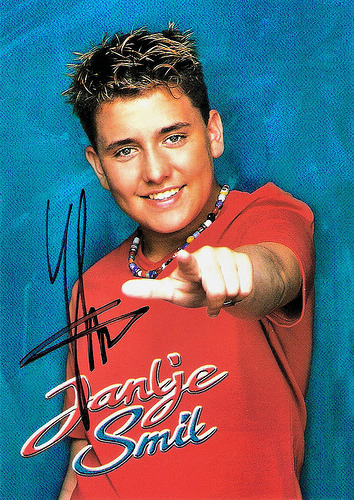
German autograph card by Koch Universal, Planegg / München.
Best National Singer
Johannes Hendricus Maria (Jan) Smit was born in Volendam, The Netherlands, in 1985. His parents are Gerda and Ruud Smit. He has two sisters, Jenny Smit and pop singer Monique Smit.
As a kid, Jantje sang for four years with the boys choir De zangertjes van Volendam. At the age of ten, he was discovered when the band BZN was looking for a young local talent who could sing a duet with BZN singer Carola Smit (no relation). Jantje was chosen and their number Mama was a great success.
Following this success, he made a solo single record, Ik zing dit lied voor jou alleen (I sing this song for you alone) produced by three BZN members, Jan Keizer, Jack Veerman and Jan Tuijp. This single topped the Dutch charts.
In the following two years, Jantje Smit scored five more hits including Pappie, waar blijf je nou (Daddy, where are you now). Jantje was also successful in Belgium, Germany, Austria, Italy and France. For some time, he often performed in Germany and he recorded ten German albums. In 2001 Smit and his BZN producers received the Dutch export price for the best-selling Dutch act abroad.
At the age of 16, he left school to focus on his musical career. At 17, he changed his choice of music and started to work with the known song writers Cees Tol and Thomas Tol. A few years later he started to write by himself, together with good friend Simon Keizer, who later made name as a singer himself. Together with Nick Schilder, Simon forms a group named Nick & Simon.
In 2005, the daily life of Jan Smit could be followed in the Dutch reality show Gewoon Jan Smit (Just Jan Smit). The program received that year the Golden Televizier Ring, a major television award in The Netherlands. He also started to present TV shows like Muziekfeest op het Plein (Music Party at the Square) and he scored hit after hit with songs like Laura.
The popularity of Smit grew huge in the Netherlands. In 2006, Jan Smit was awarded the Edison Award as Best National Singer for his album Jansmit.com. In September 2006, a second series of Gewoon Jan Smit (Just Jan Smit) aired. In September 2006, C&A clothing store launched the collection J-style named after Jan Smit. Jan seemed to be everywhere.
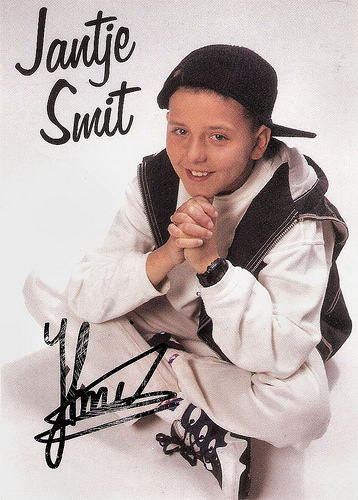
Dutch autograph card by Volendam Music, Volendam.
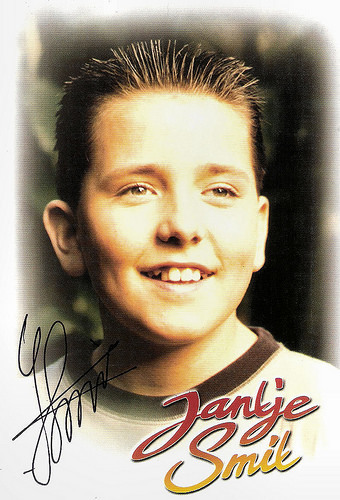
German autograph card by Koch Music, Planegg / Munich.
Slashed by both critics and the public
In the following years, Jan Smit continued to score number one hits and to present TV shows. In 2007, he won a TMF Award for Best Dutch Pop Act. In 2009 he released a duet with the Surinamese singer Damaru, Mi Rowsu (A little garden in my heart), which reached the number 1 position in both Suriname and the Netherlands. From 2011 on, he and Cornald Maas are the Dutch commentators for the Eurovision Song Contest, one of Europe’s biggest yearly TV events.
Jan Smit starred in the film Het Bombardement/The Bombardment (Ate de Jong, 2014) with Roos van Erkel and Monic Hendrickx. The film, about the bombing of the city of Rotterdam in 1940 by the Nazis, was slashed by both critics and the public, but Smit was spared, his theme song went to no. 1 at the Dutch charts and the film still attracted more than 100,000 visitors.
Since 2012 Smit presents the TV show De beste zangers van Nederland (The finest singers of the Netherlands). He also founded with his manager Jaap Buijs the record label Vosound Records. Artists who record for this label are his sister Monique Smit, Tim Douwsma and Gerard Joling.
In 2011, he performed three nights at the Amsterdam Arena stadium during the concert series Toppers in Concert. In December 2013 Smit joined the board of soccer club FC Volendam. In 2014, he played a supporting role in the popular TV series Flikken Maastricht/Cops Maastricht (2007-) with Angela Schijf and Victor Reinier.
With the Schlager group KLUBBB3 (including German singers Florian Silbereisen and Fleming Christoff), Smit tried to conquer the German market once more. Their debut album Vorsicht unzensiert! (Attention, not censured) reached number 4 to 6 in Germany, Austria and Belgium and was also recorded in the Netherlands and Switzerland. In 2017 the trio was awarded the prize Die Eins der Besten in the category Best Band of the year. Their second album Jetzt Geht's Los Richtig (Now it's time to get it right) entered at no. 1 in Germany, number two in Austria and number three in Switzerland. Their single Life Dances Sirtaki became a no. 1 hit in The Netherlands.
In Germany Smit guest starred in the popular TV series Das Traumschiff/The Dream Boat (2017) with Heide Keller and Sascha Hehn. In 2017, Smit also joined the Dutch vocal band De Toppers, consisting of René Froger, Jeroen van der Boom and Gerard Joling. Since 2005, the band yearly gives a series of hugely successful outdoor concerts in the Amsterdam ArenA stadium. In 2011 and 2013 Smit was a guest artist during Toppers in Concert.
Jan Smit had a relation with actress and presenter Yolanthe Cabau van Kasbergen from 2007 till 2009. Since 2009, Smit has a relation with Liza Shelf. The two were married in 2011 and they have three children.
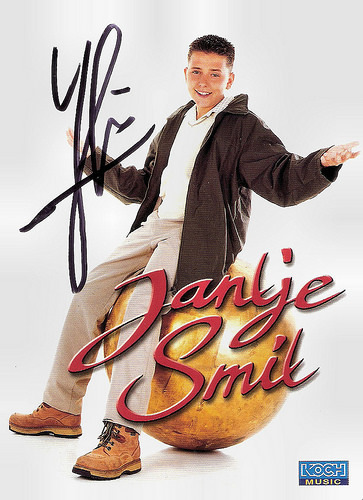
German autograph card by Koch Universal, Planegg / München.
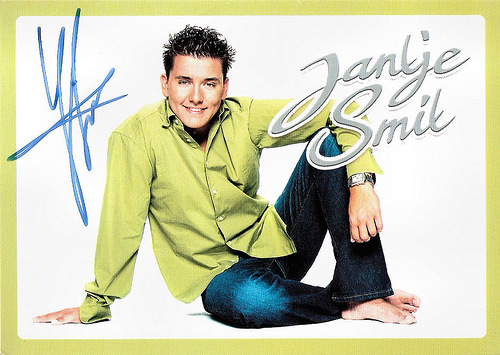
German autograph card by Koch Universal, Planegg / München.
Trailer Het Bombardement/The Bombardment (Ate de Jong, 2014). Source: Dutch Film Works (YouTube).
KLUBBB3 performs Das Leben tanzt Sirtaki. Source: ICH FIND SCHLAGER TOLL! (YouTube).
Sources: (IMDb), Wikipedia (English and Dutch), and .

German autograph card by Koch Universal, Planegg / München.
Best National Singer
Johannes Hendricus Maria (Jan) Smit was born in Volendam, The Netherlands, in 1985. His parents are Gerda and Ruud Smit. He has two sisters, Jenny Smit and pop singer Monique Smit.
As a kid, Jantje sang for four years with the boys choir De zangertjes van Volendam. At the age of ten, he was discovered when the band BZN was looking for a young local talent who could sing a duet with BZN singer Carola Smit (no relation). Jantje was chosen and their number Mama was a great success.
Following this success, he made a solo single record, Ik zing dit lied voor jou alleen (I sing this song for you alone) produced by three BZN members, Jan Keizer, Jack Veerman and Jan Tuijp. This single topped the Dutch charts.
In the following two years, Jantje Smit scored five more hits including Pappie, waar blijf je nou (Daddy, where are you now). Jantje was also successful in Belgium, Germany, Austria, Italy and France. For some time, he often performed in Germany and he recorded ten German albums. In 2001 Smit and his BZN producers received the Dutch export price for the best-selling Dutch act abroad.
At the age of 16, he left school to focus on his musical career. At 17, he changed his choice of music and started to work with the known song writers Cees Tol and Thomas Tol. A few years later he started to write by himself, together with good friend Simon Keizer, who later made name as a singer himself. Together with Nick Schilder, Simon forms a group named Nick & Simon.
In 2005, the daily life of Jan Smit could be followed in the Dutch reality show Gewoon Jan Smit (Just Jan Smit). The program received that year the Golden Televizier Ring, a major television award in The Netherlands. He also started to present TV shows like Muziekfeest op het Plein (Music Party at the Square) and he scored hit after hit with songs like Laura.
The popularity of Smit grew huge in the Netherlands. In 2006, Jan Smit was awarded the Edison Award as Best National Singer for his album Jansmit.com. In September 2006, a second series of Gewoon Jan Smit (Just Jan Smit) aired. In September 2006, C&A clothing store launched the collection J-style named after Jan Smit. Jan seemed to be everywhere.

Dutch autograph card by Volendam Music, Volendam.

German autograph card by Koch Music, Planegg / Munich.
Slashed by both critics and the public
In the following years, Jan Smit continued to score number one hits and to present TV shows. In 2007, he won a TMF Award for Best Dutch Pop Act. In 2009 he released a duet with the Surinamese singer Damaru, Mi Rowsu (A little garden in my heart), which reached the number 1 position in both Suriname and the Netherlands. From 2011 on, he and Cornald Maas are the Dutch commentators for the Eurovision Song Contest, one of Europe’s biggest yearly TV events.
Jan Smit starred in the film Het Bombardement/The Bombardment (Ate de Jong, 2014) with Roos van Erkel and Monic Hendrickx. The film, about the bombing of the city of Rotterdam in 1940 by the Nazis, was slashed by both critics and the public, but Smit was spared, his theme song went to no. 1 at the Dutch charts and the film still attracted more than 100,000 visitors.
Since 2012 Smit presents the TV show De beste zangers van Nederland (The finest singers of the Netherlands). He also founded with his manager Jaap Buijs the record label Vosound Records. Artists who record for this label are his sister Monique Smit, Tim Douwsma and Gerard Joling.
In 2011, he performed three nights at the Amsterdam Arena stadium during the concert series Toppers in Concert. In December 2013 Smit joined the board of soccer club FC Volendam. In 2014, he played a supporting role in the popular TV series Flikken Maastricht/Cops Maastricht (2007-) with Angela Schijf and Victor Reinier.
With the Schlager group KLUBBB3 (including German singers Florian Silbereisen and Fleming Christoff), Smit tried to conquer the German market once more. Their debut album Vorsicht unzensiert! (Attention, not censured) reached number 4 to 6 in Germany, Austria and Belgium and was also recorded in the Netherlands and Switzerland. In 2017 the trio was awarded the prize Die Eins der Besten in the category Best Band of the year. Their second album Jetzt Geht's Los Richtig (Now it's time to get it right) entered at no. 1 in Germany, number two in Austria and number three in Switzerland. Their single Life Dances Sirtaki became a no. 1 hit in The Netherlands.
In Germany Smit guest starred in the popular TV series Das Traumschiff/The Dream Boat (2017) with Heide Keller and Sascha Hehn. In 2017, Smit also joined the Dutch vocal band De Toppers, consisting of René Froger, Jeroen van der Boom and Gerard Joling. Since 2005, the band yearly gives a series of hugely successful outdoor concerts in the Amsterdam ArenA stadium. In 2011 and 2013 Smit was a guest artist during Toppers in Concert.
Jan Smit had a relation with actress and presenter Yolanthe Cabau van Kasbergen from 2007 till 2009. Since 2009, Smit has a relation with Liza Shelf. The two were married in 2011 and they have three children.

German autograph card by Koch Universal, Planegg / München.

German autograph card by Koch Universal, Planegg / München.
Trailer Het Bombardement/The Bombardment (Ate de Jong, 2014). Source: Dutch Film Works (YouTube).
KLUBBB3 performs Das Leben tanzt Sirtaki. Source: ICH FIND SCHLAGER TOLL! (YouTube).
Sources: (IMDb), Wikipedia (English and Dutch), and .
Published on September 25, 2017 22:00
Paul van Yperen's Blog
- Paul van Yperen's profile
- 13 followers
Paul van Yperen isn't a Goodreads Author
(yet),
but they
do have a blog,
so here are some recent posts imported from
their feed.



